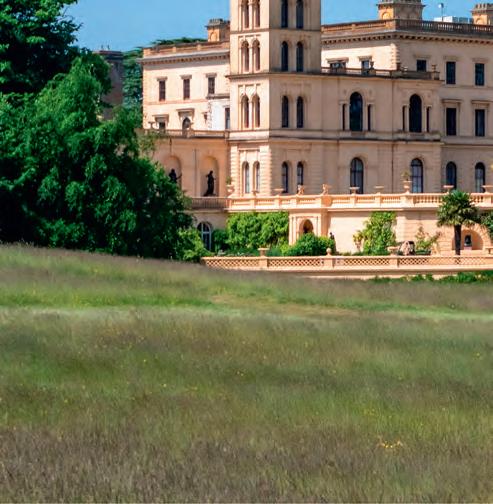

STORM THE GATES

CONTRIBUTORS

Dr Jennifer Wexler
Senior properties historian
On page 17, Jennifer explains how a rare astrological event is revealing Stonehenge’s story

Dr Frances McIntosh
Collections curator
Sixty years after the discovery of the Corbridge Hoard, Frances reveals its treasures on page 44

Howard Spencer
Senior historian, blue plaques
On page 66, Howard reveals the story of former Olympic boxer Harry Mallin
Get in touch
W www.english-heritage.org.uk/members E membersmagazine@ourmedia.co.uk (for magazine queries only) or members@english-heritage.org.uk (for membership queries and changes of address)
T 0370 333 1181
PO Box 569, Swindon, SN2 2YP
For English Heritage
Louise Dando, Johanna Lovesey, Megan Anders, Tony Dike, Daniel Di Paolo, Tersia Boorer, Tom Moriarty, Richard Leatherdale

We’re working hard to make our sites and stories accessible to everyone
Heritage is for all of us, and we’re committed to breaking down barriers to ensure everyone can access our sites and feel connected to England’s past. We’re working hard to make our charity a really inclusive place to work and volunteer, and we’re also doing more than ever to engage with the communities around our sites. If you’d like to be part of this exciting new chapter of our story, visit our website to find out how you can work or volunteer with us.
For Our Media
Group editor Matt Havercroft
Managing editor Oliver Hurley
Senior art editor Steve Gotobed
Senior account director Esther Procee
Account manager Joanne Robinson
Director Julie Williams
Editorial director Dan Linstead
Advertising manager Jamie Bolton
E jamie.bolton@ourmedia.co.uk
Contributors
Dr Jennifer Wexler, Carolyn Boyd, Monisha Rajesh, Dr Frances McIntosh, Dr Andrew Hann, Gabrielle Jaffe, Dr Nick Holder, Suzannah West, Howard Spencer, Eleanor Matthews
You’ll find lots of inspiration for great days out in this issue. Relive the 1216 Great Siege of Dover Castle in Kent on page 18, tour a Neolithic flint mine in Norfolk (page 26) or plan a weekend exploring history on the wild Northumberland coast (page 38).
Whatever you’re planning, don’t forget to make the most of your exclusive discounts, including our members’ kids eat free offer (page 34). Have a great summer.
Dr Nick Merriman Chief Executive
English Heritage Members’ Magazine is published three times a year, in March, July and October, on behalf of English Heritage by Our Media, Eagle House, Bristol, BS1 4ST T 0117 927 9009 W www.ourmedia.co.uk
Support us
English Heritage is a charity. Without the support of our members and donors, our work would not be possible. To find out more about how you can help by making a donation or leaving a gift in your will, please visit www.english-heritage.org.uk/support-us or call the fundraising team on 020 7973 3797.
English Heritage cares for more than 400 historic monuments, buildings and places –from world-famous prehistoric sites to grand medieval castles, and from Roman forts on
Through these we bring the
of
to life for more than 10 million visitors each year.
Registered charity no. 1140351 (England)


the edges of the empire to Cold War bunkers.
Story
England
‘This

18
New this season
Dover Castle under siege
Explore the story of the invasion that decided the fate of the nation
30
Great days out
Record-setting sites
The superlative sites you need to see, from the biggest to the most ancient
38
On the road
A weekend in Northumberland
Monisha Rajesh and family go in search of ruined castles and monasteries
46 Stories of England
At your service
Discover what it took to run a Victorian country house, including a team of servants
51 Expert care Reculver rescue
The project to conserve this ruined church and Roman fort on the Kent coast
66 Past lives
Olympic boxer Harry Mallin
We reveal the Paris 1924 Olympic champion commemorated with a London blue plaque

Cover image
A family take in the view of Dover Castle’s northern defences, where the Great Siege of 1216 took place
instagram.com/englishheritage facebook.com/englishheritage threads.net/@englishheritage Eagle House, Bristol, BS1 4ST membersmagazine@ourmedia.co.uk


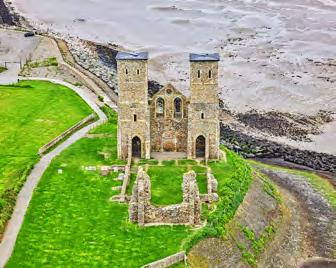


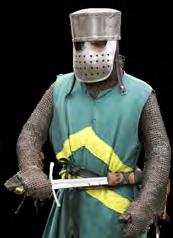
Turn to page 12 Your
Start planning unforgettable days out with our unmissable events
06
Big picture
Get ready for history and high drama at The Night of Legends events
08 Update
Our latest news and inspiration for days out with your membership
17 In my view
The rare lunar event helping to reveal the story of Stonehenge
26 Meet the expert Time Team’s Phil Harding at Grime’s Graves in Norfolk
44 Close up The Corbridge Hoard on the 60th anniversary of its discovery
65 20 questions
Put your knowledge of our castles to the test with this fiendish quiz
OVER TO YOU
57 Your say
Your thoughts on days out at our sites, the magazine and much more
58 Ask the experts
Our panel of experts tackle your questions
61 My favourite place Bridget Gunstone on the childhood home of Richard III
62 Members’ Rewards
The latest discount offers to enjoy with your membership
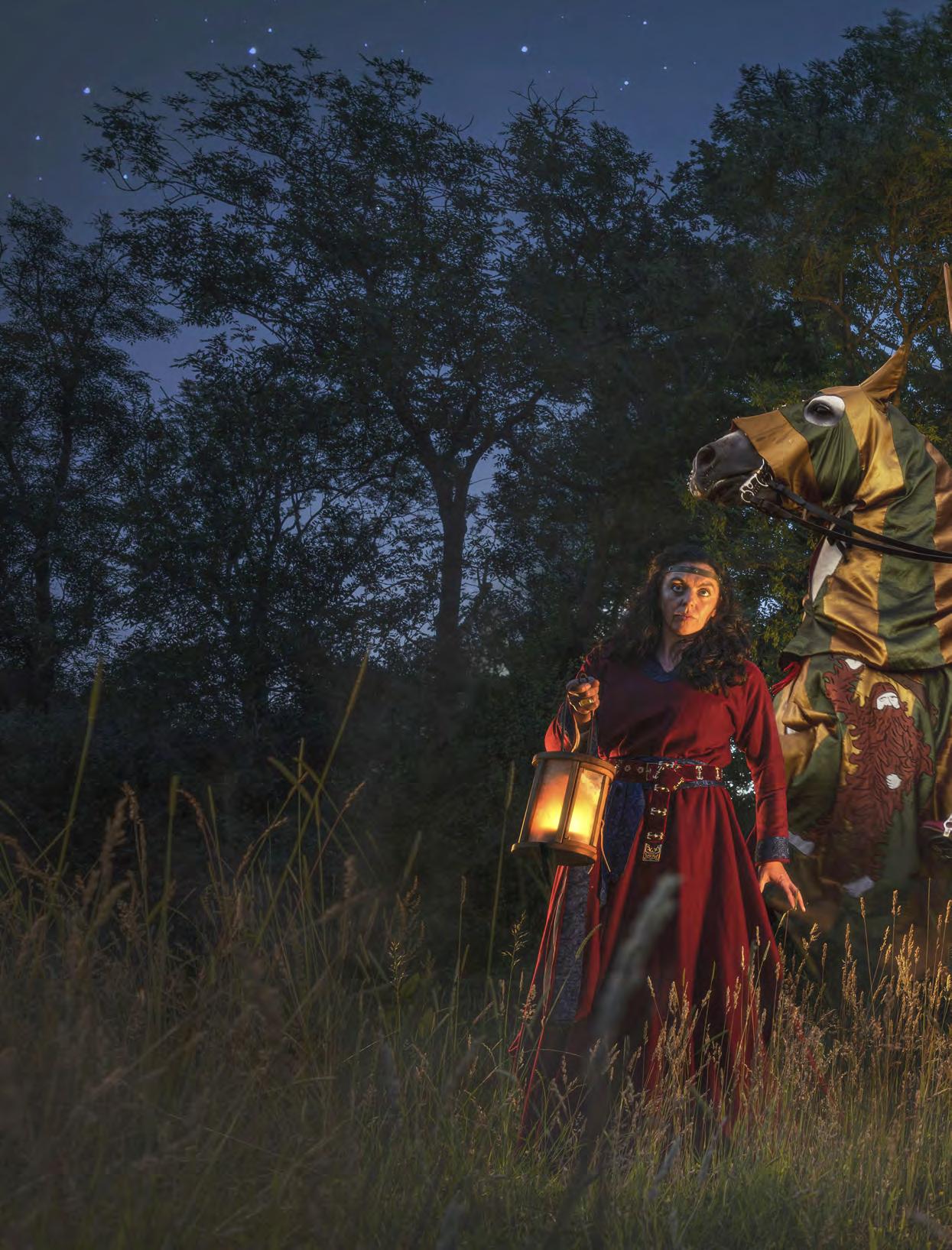
Enjoy history and high drama at Night of Legends
From 5–8 September, the grounds of Wrest Park in Bedfordshire will come alive with medieval myths and legends as a cast of entertaining characters share stories of doomed lovers, witches’ curses and mounted knights. With theatrical staging and brilliant performances in a beautiful historic setting, the Night of Legends is an unforgettably entertaining, after-hours event. Doors will be open from 6pm, so arrive early to enjoy some delicious food. www.english-heritage.org.uk/events
THE BIG PICTURE

Inspired ideas for your summer days out
See an art deco palace in full bloom
Delve into the history of a London landmark through a unique floral display that is free for members
This summer, Eltham Palace is set to host a unique exhibition that will bring its stories to life through eye-catching floral displays across the mansion and gardens. Taking place from 13–21 July, the exhibition has been organised in partnership with floral event specialist Fleurs de Villes. The displays will feature fantastical floral outfits designed by local florists to celebrate the palace’s famous residents and high-society
guests. Step inside to discover the story of Stephen and Virginia Courtauld, who transformed the ruined palace into an opulent art deco mansion. Then head into the medieval great hall to find more floral displays inspired by Eltham’s royal past, when it played host to kings, queens, and the Tudor court. For more details on the displays or to book tickets, go to: www.english-heritage.org.uk/ eltham-fleur-de-villes
‘Eltham Palace will host a unique exhibition bringing its stories to life through eye-catching floral displays’
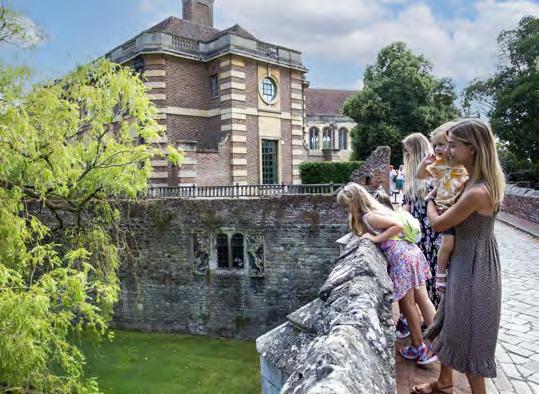
MEMBERS GET MORE
Register on our new Members’ Area for more

The displays will celebrate Eltham Palace’s glamorous heyday in the 1930s
Days out
Discover the ‘Stonehenge of the North’
Marvel at North Yorkshire’s reunited Neolithic monuments
One of Britain’s most significant prehistoric monuments has been united under a single owner for the first time in 1,500 years after we acquired the third henge at Thornborough Henges. The northern henge now joins the central and southern henges, which were gifted to Historic England and English Heritage in 2023. The Thornborough Henges comprise three
Conservation

Thornborough Henges comprises three giant prehistoric earthworks
earthworks that date from 3000 to 2500 BC. After safety works are completed at the northern henge, visitors will be able to access all three monuments. The acquisition was completed with the support of The National Heritage Memorial Fund, Jamie Ritblat and family, and The SCS Trust. www.english-heritage.org.uk/ thornborough-henges
Step inside reopened mansion ruins
Explore the interiors of Sutton Scarsdale Hall following extensive conservation work
After being closed for nine years, Sutton Scarsdale Hall in Derbyshire is reopening to visitors this summer. For almost a decade, only the exterior of this baroque manor house was accessible, but it is now also possible to go inside the imposing shell of the grandiose Georgian building. Visitors will be able to explore the remnants of the once-majestic interior, which still includes traces of ornate plasterwork, following extensive repairs and the removal of invasive vegetation from its walls. Built for the
The hall was built in the baroque style for the 4th Earl of Scarsdale
4th Earl of Scarsdale in 1724–29, the hall has been a roofless shell since 1919, when the Scarsdale heirs were forced to sell the property due to spiralling costs. Many of its finely decorated rooms were dismantled and sold as architectural salvage, with some exported to America. www.english-heritage.org.uk/ sutton-scarsdale-hall

MARBLE HILL ADVENTURE Don’t miss our new interactive smartphone adventure game, taking place at Marble Hill in London until September, with live events on selected weekend dates. www.english-heritage.org.uk/marble-hill-game

Q&A
Jester minute
Our fire-breathing fool Rob Sim celebrates 20 years of shows
What made you become a jester?
I’ve been a full-time entertainer all my life. As time went on I became more interested in the history of jestering. My first performance for English Heritage was 20 years ago, which makes me one of their longest serving performers, if not the longest!
What happens in your shows?
The shows can include firebreathing, juggling, stiltwalking, magic, unicycling and escapology, and there’s lots of audience participation too.
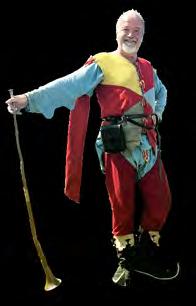
Do you replicate what medieval jesters did?
My aim is to try to be true to the flavour of being a jester without it being a reconstruction. I’d like to think the silliness and chaos of my shows would have gone down well in the medieval era.
Where can we see you perform?
I’ll be at a host of Legendary Joust, Knights’ Tournament and Fighting Knights events throughout July and August. www.english-heritage.org.uk/ events

Explore women’s history
Discover the stories of six inspiring women
Six women of outstanding achievement have been celebrated by recent London blue plaques. The novelist Iris Murdoch (1919–99, below) once wrote that London was ‘another main character in my fiction’, and is commemorated at her former flat in Kensington.

Peggy Ashcroft (1907–91), a star of stage and screen, is honoured at her childhood home in Croydon. Joan Clarke (1917–96), one of the code breakers at Bletchley Park, is remembered with a plaque in West Dulwich, and Joan Robinson (1903–83), arguably the first woman economist of note, is memorialised in Kensington. Irene Barclay (1894–1989), the first qualified woman surveyor, has a plaque on her former office in Camden. Marjory Allen (1897–1976) achieved renown as a landscape architect and designer of innovative children’s playgrounds. Her house in Chelsea bears her blue roundel.
New view
Take a night flight
Admire the view from reinstated medieval monks’ night stairs
A staircase once used by weary medieval monks to attend church services in the middle of the night has been reconstructed at Furness Abbey in Cumbria. The new timber structure has been installed on the site of the original, allowing visitors to climb to the monks’ dormitory, where you can enjoy views of the ruins that have long captivated visitors, including artist JMW Turner and poet William Wordsworth. Furness Abbey was the first large monastery to be suppressed during the Reformation. ‘Founded 900 years ago, Furness was a place of prayer, piety and pilgrimage,’ says senior properties historian Dr Michael Carter. ‘By reinstating the night staircase, we are enabling visitors to look back in time and see these ruins through the eyes of the monks themselves.’ www.english-heritage.org.uk/furnessabbey
National Garden Scheme
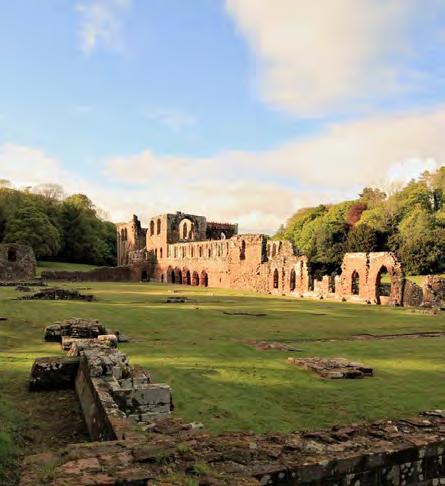
‘By reinstating the night staircase, we are enabling visitors to see the ruins through the eyes of the monks’
Enjoy an after-hours garden tour
Join our head gardeners to discover the secrets of four of our finest gardens
This summer, you can join our gardeners for evening tours of our historic gardens after the sites are closed. Organised in partnership with the National Garden Scheme, the tours will provide an insight into how we develop these wonderful spaces. www.english-heritage.org.uk/ events
12 July, 5.30pm
Kenilworth Castle and Elizabethan Garden, Warwickshire
Join garden supervisor Phillip Corrall for a tour of the recreated Elizabethan Garden at the castle where Robert Dudley, Earl of Leicester, entertained Queen Elizabeth I.
23 July, 5.30pm Down House, Kent Meet head gardener Anthony O’Rourke and discover the garden where naturalist Charles Darwin conducted experiments while developing his theory of evolution.

14 August, 5.30pm
Brodsworth Hall and Gardens, South Yorkshire Join head gardener Dan Hale for a tour of the restored Victorian gardens at the Thellusson family’s home.
18 September, 5.30pm Audley End House and Gardens, Essex Take a tour of the gardens with head gardener Louise Ellis and admire the work of landscape designer Capability Brown.

Enjoy a guided tour of the gardens at Brodsworth Hall
The abbey ruins sit in a peaceful wooded valley
More ways to support us
Your membership means so much to us but, as a charity, we can’t survive without donations. Here are more ways you can make a difference
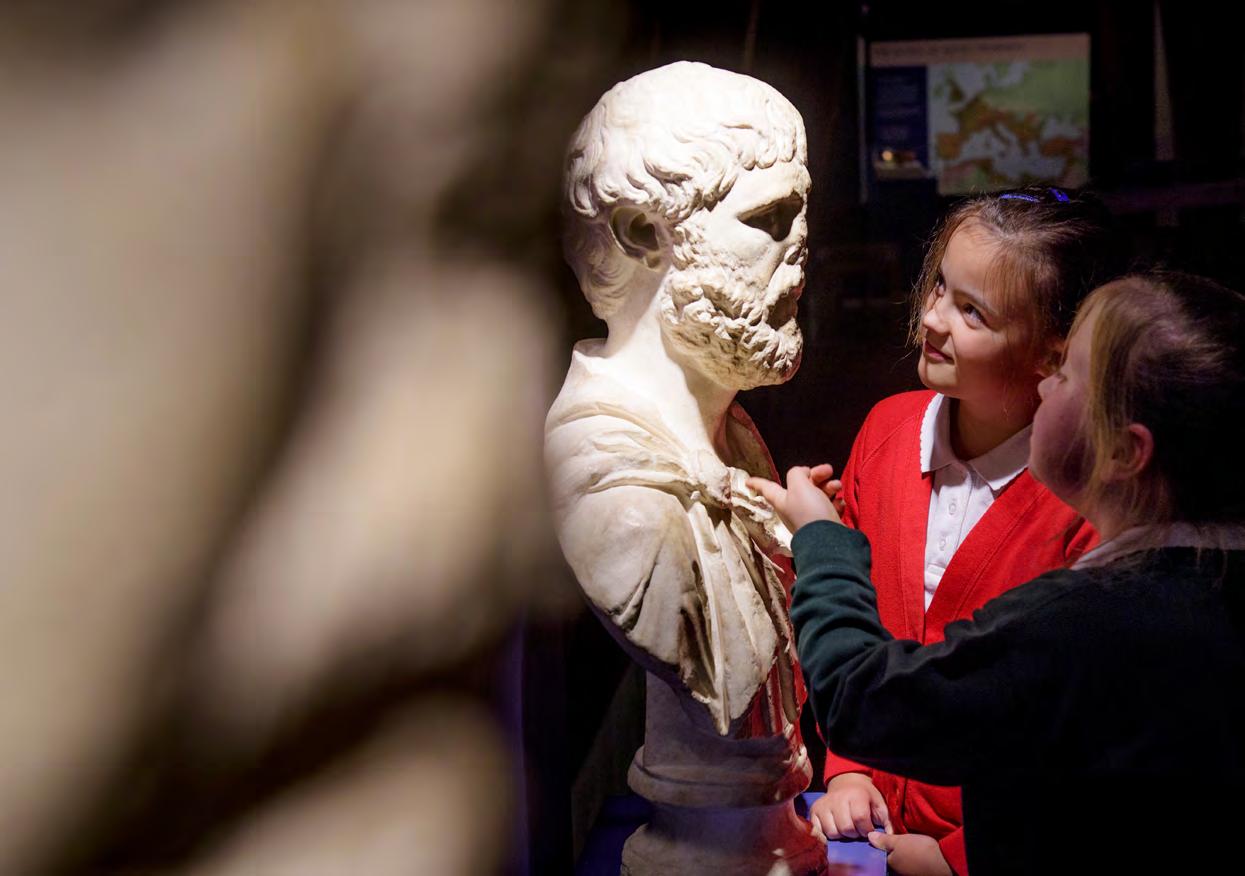

Become an English Heritage Guardian
As a Guardian, you’ll be a champion of the charity, with chances to get even closer to England’s heritage, thanks to exclusive experiences and one-off events. You’ll play your part in funding major projects, you’ll help acquire and conserve historic objects and you’ll be joining a community of like-minded people who share your passion for the past. To find out more, contact us at: guardians@english-heritage.org.uk

Join the Blue Plaques Circle
The London blue plaques scheme is over 150 years old, and there are more than 1,000 plaques across the capital. But the scheme’s future relies on your support. Members of the Blue Plaque Circle get an unrivalled opportunity to go behind the scenes to meet experts, attend unveilings and spend time with other blue plaque devotees. Membership costs £5,000 per year. To speak about joining, contact us at: fundraising@english-heritage.org.uk

Leave a gift in your will
Whether you’re passionate about a particular place or you’d like to support our wider work, you can help to look after England’s heritage for years to come by leaving a gift in your will. We’re offering a free will writing service with makeawillonline. co.uk. It’s a simple process, with a fully qualified solicitor on hand to check each will. To receive a brochure or speak to our team, contact us at: legacies@english-heritage.org.uk
What’s On
Unmissable summer events

Where’s My Shadow?

Summer Quest
Get ready to embark on an exciting family adventure at a site near you Noble, our trusty guard dog, has lost his shadow. And he needs the help of some little adventurers to find it. Without his shadow, Noble could lose his imagination forever! We need someone bursting with creativity and wonder to help him find it again before it’s too late. Could that hero be you? Meet Noble’s friends and join the search for this shadow at over 28 sites nationwide to crack the quest.
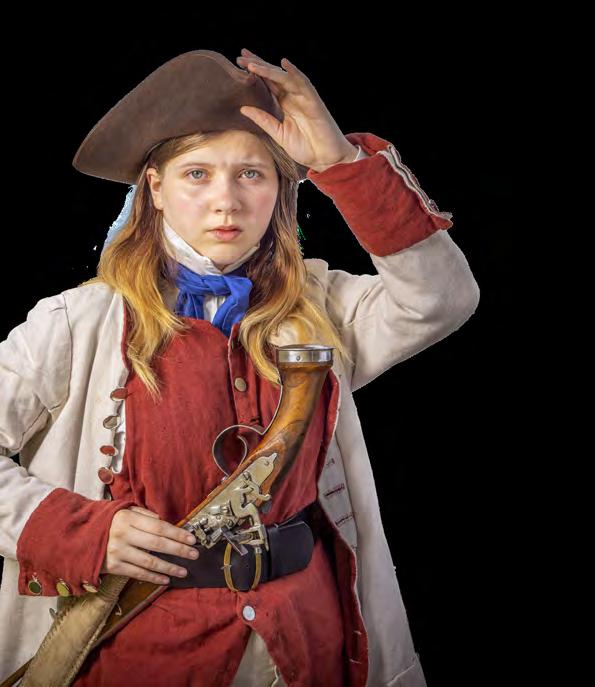
Pirates!
Discover tales of the high seas at our interactive shows
Ahoy, me hearties! Get ready for a spectacular adventure on the high seas at Carisbrooke Castle on the Isle of Wight and Dover Castle in Kent. See some of history’s most famous pirates fight it out at close quarters, listen to them tell their tales of booty, bounty and barnacles, learn the ropes in pirate school and sing along to sea shanties. Children and adults alike will be immersed in tales of scallywags and salty sea dogs.
‘Listen to history’s most famous pirates tell tales of booty, bounty and barnacles’
Many events are free or discounted for members. Find our full listings at www.english-heritage. org.uk/events
Heritage Live
Enjoy open-air concerts in the grounds of one of England’s grandest mansions
This summer sees the return of Heritage Live concerts to Audley End House in Essex, and members can save 10% (offer valid on tickets purchased from 1–31 July). This year’s acts include Suede (1 Aug), Madness (2 Aug), Richard Ashcroft (3 Aug) and Elbow (4 Aug). Book online at www.english-heritage.org.uk/rewards.

Legendary Jousts
Watch legendary knights compete for honour and glory
Experience the exhilarating spectacle of speed and skill as four legendary knights compete for honour and glory at these touring events across the country. See lances shatter, feel the thunder of hooves and hear the roar of the crowd as reputations are won and lost.

Our Legendary Events series is supported by Subaru
Members’ exclusive events
Sat 27 Jul–Mon 26 Aug, 9am–10am KNIGHT CLUB
Nationwide
Join our exclusive members-only Knight Club for an enhanced experience at the Knights’ Tournament events taking place at sites across the country. Hang out with the knights in their camp before the site opens, and receive a special goody bag to take home. Please note, you’ll need to buy tickets for the Knight Club in addition to tickets for the Knights’ Tournament. Knights’ Tournament: £1.50 for children, adults £2.50. Knight Club: £5 per person (children must be 4+)

Sun 4 Aug, Sun 1, Thu 26 & Sun 29 Sep, Sun 20 Oct, 11am–12pm & 2pm–3pm
UNEXPECTED OSBORNE
Osborne, Isle of Wight
Unexpected Osborne takes you through Osborne’s lesser-known histories, beginning with its early days as the home of the Blachford family in the 18th century to when it closed after the last patient left the Edward VII Convalescent Home for Officers in 2000. Along the way you will be taken through stories of the Royal Naval College, which was first established at Osborne in 1903, and Osborne’s role in the First World War. The tour will also highlight the key features of the estate, such as the ice house, that were crucial to life on a Victorian estate. £15. Access: moderate
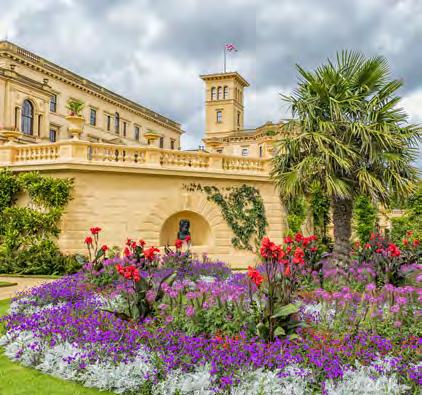

Wed 7 Aug, 10.15am–12.15pm CHESTER CATHEDRAL AND CITY TOUR Chester, Cheshire
It is said there has been a church on the site of Chester Cathedral since Roman times. Hear how Benedictine monks rebuilt the Saxon church into a magnificent monastery, with architecture from Romanesque to Gothic. Learn about 450 years of intrigue relating to the inhabitants of the monastery, which was one of England’s wealthiest until Henry VIII’s Dissolution of the Monasteries in the 16th century. £25. Access: moderate
Fri 16 Aug, 11am–1pm
Bookings open on 9 July 2024
CHURCHILL’S SECRET ARMY Audley End House and Gardens, Essex
Discover the clandestine wartime history of Audley End House, codenamed Station 43, the stately home used to train elite paratroopers of the Polish Cichociemni, or the Silent Unseen. Join us to uncover evidence throughout the house of the Polish Section of the Special Operations Executive, which trained special forces in covert operations, sabotage and intelligence gathering, and find out more about the brave men and women who trained here from 1942–44 in preparation for covert action behind enemy lines. £35. Access: moderate
‘Codenamed Station 43, Audley End House was used to train elite paratroopers’


Sun 1 Sep, 11am–1pm THE BATTLE OF FLODDEN Branxton, Northumberland
Join Julian Humphrys of the Battlefields Trust on a walk around the site of this fiercely contested battle, which saw the defeat and death of King James IV of Scotland at the hands of an English army under the Earl of Surrey. To this day, Flodden is a remarkably unchanged battlefield with some stunning views. £25. Access: challenging
Sat 7 Sep, 11am–1pm
LONDON WALK: GREAT FIRE OF LONDON
Monument underground station, London
Join London tour guide Nick Collinson as he tracks the most destructive fire in London’s long history. Listen to eye-witness accounts as you explore the medieval lanes and alleyways that succumbed to the sparks from a negligent baker’s oven. Understand why the fire got out of control and who paid for the disaster, which resulted in 70,000 people being made homeless. £25. Access: moderate


Sat 14 Sep, 5.30pm–7pm THE ESCAPE OF CHARLES II
Boscobel House, Staffordshire
Find out about Charles II’s extraordinary escape after his defeat at the battle of Worcester in 1651 in this special evening event. See where Charles hid in the house and visit the Royal Oak, a descendant of the tree that Charles famously climbed to hide from his parliamentarian pursuers.
£25. Access: easy
Fri 27 Sep, 2.30pm– 5pm BRIDGET ATKINSON SHELL COLLECTION
Thu 12 Sep, 10.30am–12.30pm EXPERIENCE YORKSHIRE: WHITBY WALKING TOUR
Whitby Abbey, North Yorkshire
Join guide Sarah Milne-Day on a tour of the iconic seaside town of Whitby. Starting at the spectacular ruined abbey, we will head down the 199 steps into the picturesque town and harbour to discover the history, industry and characters that make this such a fascinating place. Expect to discover secrets around every corner. £25. Access: challenging
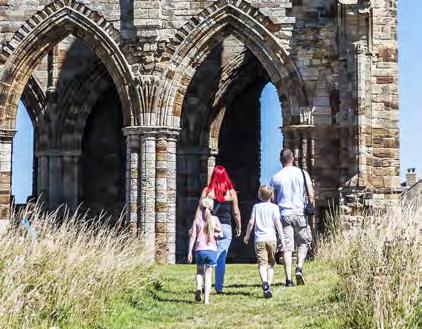
Wed 9 Oct, 10.15am–12.15pm
SECRETS OF CHESTER WALKING TOUR
Storyhouse Cinema, Chester
DISCOVER
MORE
For details of all our memberexclusive events, go to www.english-heritage. org.uk/members -events
Chesters Roman Fort and Museum, Northumberland
Meet Dr Frances McIntosh, collections curator, and Richard Atkinson, many times great-grandson of Bridget, to hear all about this fascinating collection. Learn more about Bridget the collector and the world she lived in. Get up close with some of the shells and discover their stories. This event also includes refreshments. £25. Access: easy
Shells from Bridget Atkinson’s collection
A team of mathematicians has named Chester as the prettiest city in the world, narrowly beating out Venice in Italy for the top spot. This tour will cover the wonderfully eclectic architecture and the 2,000 years of history held within the city walls – but will also show you hidden secrets of the city, such as medieval halls, Roman foundations, and secrets hidden in small cafés or down stone-hewn cellars. Join tour guide John McFerran on this exclusive small-group tour to explore some small hidden secrets of the intriguing city of Chester. £30. Access: moderate



‘Get up close with some of the shells and learn more about Bridget the collector’
Thu 10 Oct, 3.30pm–4.45pm
THE ART OF SWAGGER: STEPHEN FARTHING IN RESIDENCE Kenwood, London
Join Stephen Farthing, this year’s artist in residence at Kenwood, to discover his fascination with Grand Manner or ‘swagger’ portraits. He will go in-depth about the exhibition on show, and you will have a chance to see his current work-in-progress, inspired by his time at Kenwood. £25. Access: moderate



























IN MY VIEW
DR JENNIFER WEXLER Senior properties historian

‘A
lunar event could unlock the secrets of Stonehenge’
People have been observing the cosmos for thousands of years. While it’s common knowledge many ancient monuments have a connection with the sun, we are less familiar with the role the moon has played in their construction and use. However, there are clues the moon may have played a key role in the development of the early monument at Stonehenge.
This year, we have an opportunity to study this connection during the major lunar standstill that is taking place in 2024–25. During this rare astronomical event, which occurs only every 18.6 years, the northernmost and southernmost positions of the moon are furthest apart along the horizon. It’s believed that these distinct lunar movements may have been observed during the early phase of Stonehenge, potentially influencing the later monument’s design and purpose.
In the earliest phases of Stonehenge, around 5,000 years ago, people began burying cremated remains there and in the Aubrey Holes – 56 pits, which may originally have housed upright timber posts or stones. Many of these cremations were concentrated in the south-east of the monument, aligning with the most southerly rising position of the moon.
There is a further lunar connection at Stonehenge as the long axis of the rectangle formed by the four Station Stones also shares this orientation. Researchers have debated for years whether this was deliberate and, if so, how this was achieved and what might have been its purpose. The Station Stones may have been employed to help measure out the sarsen circle around 500 years after the site was first used for

‘There are clues the moon may have played a key role in the development of Stonehenge’
cremations, suggesting a compelling and enduring connection between the lunar cycles and the architecture of Stonehenge.
To investigate the alignment of the ancient stones with the moonrise and moonset during this unusual planetary period, we will be working with experts from Leicester, Bournemouth and Oxford universities. To bring the research to life for visitors, we are planning a series of events throughout the standstill season, including talks, a pop-up planetarium, stargazing and storytelling sessions, along with a display in the exhibition space. Only time will tell if our findings help to solve more of the monument’s astronomical mysteries.
See the stones
To find out more or plan a visit to Stonehenge, go to www.english-heritage.org.uk/stonehenge
Discover more
Find out more about the major lunar standstill in episode 265 of the English Heritage Podcast, available wherever you stream your podcasts. Plus, when you visit our sites with your family, look out for our new, limited edition major lunar standstill pop badge!


800 years ago, an epic siege at Dover Castle helped to stop rebellious English barons from installing a French prince as king. Later this summer you’ll be able to experience the siege’s drama in the fortifications that kept the invaders at bay, writes Carolyn Boyd

The new features at Dover Castle open on 22 July, with exclusive access for members on 20–21 July. See our website for details
Driving into Dover, it’s impossible to miss the town’s mighty fortress, towering above its famous white cliffs. Built soon after 1066 to command the shortest sea crossing to the continent, it has defended these shores for over nine centuries.
I had planned to visit the castle for many years due to a quirky family connection with the site. During the Second World War, my grandmother had been stationed in the network of secret tunnels carved into the chalk cliffs below the castle, where she was tasked with intercepting German signals. However, it was the story of another, much earlier conflict that brought me here.
In 1216, England was embroiled in a bitter civil war. Barons rebelling against the unpopular rule of King John had been joined by the armies of the French Prince Louis in Kent as he attempted to claim the English crown. John fled and many towns and castles across England fell to Louis and the rebellious barons. He was even proclaimed king in London’s St Paul’s Cathedral.
It was vital for Louis to capture Dover Castle. Standing in his way was loyalist Hubert de Burgh, Justiciar of England and a veteran castle defender. Together with a garrison of 140 knights and many more soldiers, de Burgh successfully repelled two attempts to storm the castle before destroying Louis’ fleet a few miles off the coast of Dover, near Sandwich.
Left The story of the Great Siege is the inspiration for a fantastic new play area
Right The siege took place at Dover Castle in 1216–17
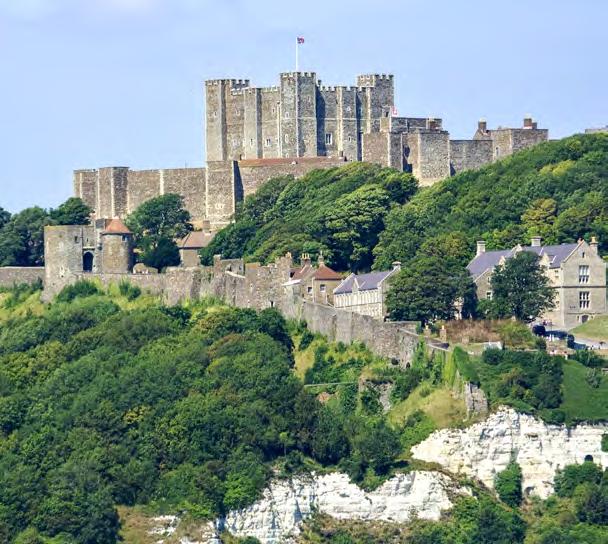
‘With new experiences spread across the castle’s northern Spur, visitors will be able to discover the events of the siege through a new exhibition and play area’
This July, the results of a major project to immerse visitors in the story of the Great Siege of Dover Castle will be revealed. With new experiences spread across four areas of the castle’s northern Spur, where the sieges took place, visitors will be able to discover the events of the siege through a new exhibition and a siege-themed play area. From here, you will then descend into tunnels underneath the Spur, where information panels, projections and audio installations continue the storytelling, before emerging out on to a new viewing area to look back over the northern defences of the castle.
The main part of the exhibition, entitled Dover Castle Under Siege, will be housed in five adjoining Georgian casemates that once served as barracks during the Napoleonic Wars in the late 18th and early 19th centuries. As head of historic properties Neil McCollum explained, their setting is also significant on another level: ‘The casemates were built on the site of the original medieval gatehouse that was undermined and breached by the French in the siege of 1216–17. This gives visitors a unique opportunity to step into the shoes of both the English defenders and the rebellious barons and their French allies.’
On hand to guide me around for a sneak preview were senior properties historian Paul Pattison and senior interpretation manager David Thomas. As we


stepped inside the first casemate, I was greeted by an orchestral soundtrack that helped to build the drama as illustrated wall panels and a short animated film set the scene, explaining how King John’s excessive taxes and unpopular rule had sparked a civil war that was raging in England between 1215 and 1217.
The next casemate tells the story of the siege itself. Here, a series of films reveal how Louis’ soldiers approached the gatehouse at the castle’s northernmost point. ‘We’re lucky to have an account of the siege by someone we believe was there,’ said Pattison. ‘It’s not a long account but it reveals the sequence of events. It was written by an enigmatic figure known to history as the Anonymous of Bethune and it appears in a chronicle titled The History of the Dukes of Normandy and the Kings of England.’
After a series of attacks to weaken the castle’s defences, Louis’ miners tunnelled under the twintowered stone gatehouse. Thinking they would then be able to enter the castle, the French soldiers got a nasty surprise. The film tells how John’s defenders had erected a barrier of rubble and oak posts, which held them back and caused them to suffer heavy losses. The attacking force remained outside the castle, attempting to starve out the castle’s defenders, but the English held out until a truce
Above The exhibition in the second casemate tells the story of the siege’s key players, including King John and Prince Louis Left Now home to a compelling interactive exhibition, the casemates originally served as barracks during the Napoleonic Wars
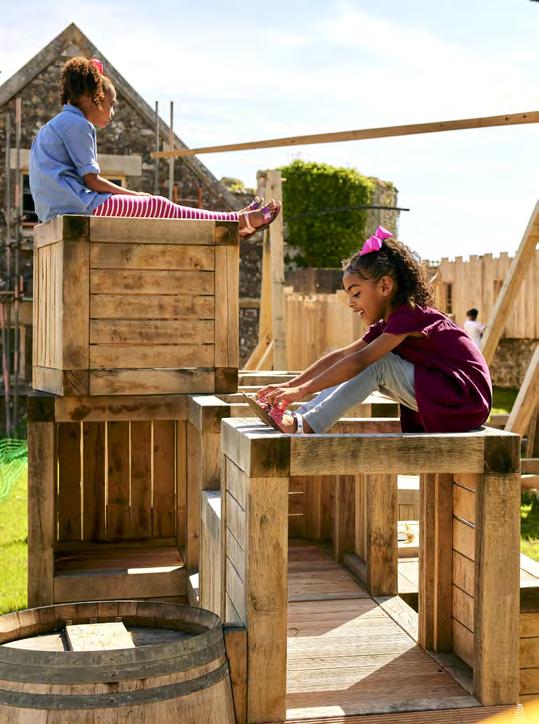

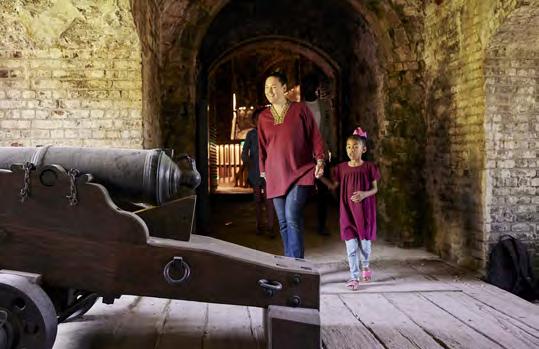
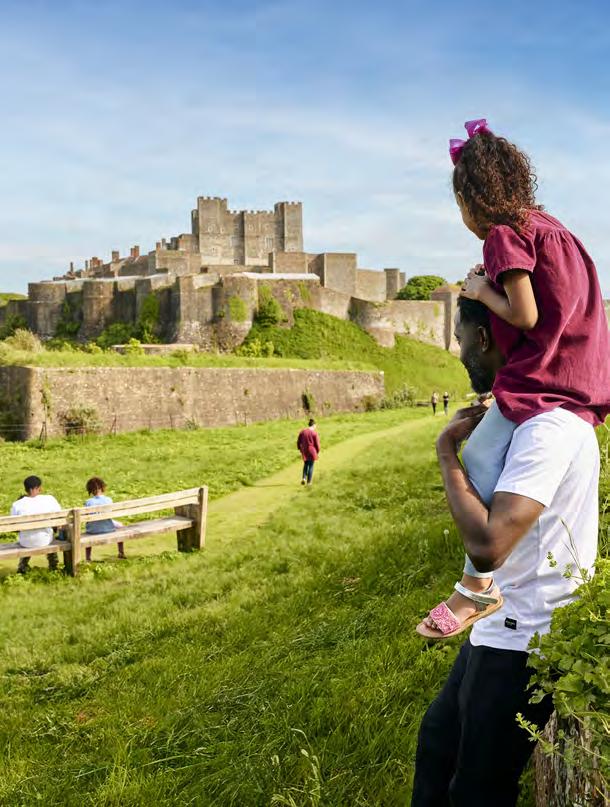
The siege experience
Explore the castle’s northern defences to learn about the Great Siege. Check online for opening information
1. The play area is themed around the Great Siege and gives youngsters the chance to learn through play, with tunnels to clamber through, trebuchets to shoot and an interactive game.
2. The casemate exhibitions tell the story of how Dover repelled its attackers. Meet the key players in the story and find out how a small
number of English defenders held off the French. In the final casemate, learn more about the soldiers who barracked there during the Napoleonic wars.
3. The Spur tunnels feature new audio-visual installations that enhance their unique atmosphere and allow visitors to understand how both medieval
defenders and those stationed at the castle during the Georgian period used the tunnels to repel invaders.
4. The northern Spur is the final stop on the tour, allowing you to enjoy one of the best views of the castle and imagine the events that took place here. The paths are accessible for pushchairs and most wheelchairs.
‘We’re lucky to have an account of the siege from a chronicle known as The History of the Dukes of Normandy and the Kings of England’

was agreed. Louis and the rebellious barons were gradually winning the war across England but a few fortresses, including Dover, were still resisting.
In October, John died unexpectedly. Louis was jubilant, thinking the country was his for the taking, but the opposite happened. ‘John’s death was very significant,’ explained Pattison. ‘The barons didn’t have any objections to his nine-year-old son, Henry III, who inherited the throne, so gradually the rebel barons defected to the side of the young king.’
Panels in the fourth casemate explain how William the Marshal, regent for the boy-king Henry, defeated Louis and the barons at Lincoln, turning the tide in favour of Henry III. Along with a timeline of the sieges and panels explaining the post-siege period, there is an interactive crossbow game.
After exploring the fifth and final casemate, dedicated to telling how Georgian soldiers were barracked at the castle during the Napoleonic Wars, we ventured back outside to explore the new play area. Featuring siege-themed equipment created by playground designer Studio Hardie, it includes a wooden tower, battlements with ladders and a tunnel. Next to this is a huge replica trebuchet that can be set and ‘shot’, a series of crates and barrels to clamber over, and an interactive game set around the castle’s well, in which children can ‘fill’ buckets by
placing them on a base before using them to extinguish imaginary fires that pop up around the area. Facing the play area are a series of smaller trebuchets, where visitors can shoot foam projectiles at castle walls, as well as ‘have a go’ catapults that you can use when staff are on hand to help.
Our next stop was the winding Spur tunnels, constructed after the 1216–17 siege to provide a concealed, defensible route to the outer walls at the northern end of the castle. We entered via a staircase that led us down into their atmospheric surroundings. ‘We’ve kept the information panels to a minimum in here because there’s a natural atmosphere in this place,’ said Thomas. ‘We wanted to retain the mystery and jeopardy of what it would have been like to be a soldier at any period in these tunnels.’
With the white cliffs providing a natural defence at the southern end of the castle, the northern Spur was the obvious place to mount an attack. ‘That’s why these defences are so important, because it was always going to be the place where attack would come,’ said Pattison.
As we worked our way down and through the tunnels, I learned how builders in the Georgian period adapted the medieval tunnels for better defence. These later additions included a caponier – a fortified room covering the ditch beyond the
‘The siege-themed play area includes a wooden tower, battlements with ladders and a tunnel. Next to this is a huge replica trebuchet that can be set and shot’
Above Visitors can get a sense of life in the barracks with Georgian soldier dressing-up outfits and accessories Right The new play area, which can be found just outside the casemates, brings together elements from the siege to fire children’s imaginations




Top left Pull on ropes to set off the replica trebuchet Left The play area is packed with different areas to explore and interact with Above The trebuchet is fully functioning but doesn’t shoot anything over the walls! Below Exploring the atmospheric tunnels


Door to the past
Graffiti by Georgian soldiers on a tower door reveals their fragile state of mind
One of the most intriguing exhibits in the new Dover Castle Under Siege exhibition is a Georgian door that features around fifty etchings by soldiers stationed here during the Napoleonic Wars. With the palpable threat of invasion by Napoleon in the early 1800s, Dover Castle was transformed into a military garrison, housing thousands of soldiers.
St John’s Tower, which had a commanding view over the vulnerable northern end of the castle, would have been guarded by six to 12 men on duty at any one time, with one or two stationed on the tower itself. With hours to kill, it seems those men put their artistic talents to use, carving graffiti into the door with knives or bayonets.
‘This graffiti provides a unique glimpse into the minds of these soldiers during such a charged period,’ said senior properties historian Paul Pattison. ‘It is a rare and precious example of the ordinary person making their mark.’

‘We followed a grassy path and, sitting in the summer sunshine, we took in the view of the castle’s northern Spur where Prince Louis’ soldiers tried in vain to break through’
castle’s curtain wall – armed with a line of cannons and spy holes to observe the tunnels above. Helping you to feel immersed in the story of the tunnels are audio installations, tension-building soundscapes and light projections that depict medieval figures such as soldiers and sappers (tunnellers).
The tunnels end at the Redan, a triangular structure that houses a series of rooms. ‘These small rooms were designed to confuse anybody breaking into the end of the tunnel, using a series of doors that were operated remotely through these movable arms,’ said Pattison, as he showed me the series of levers that could be pulled from behind other walls.
On the final stage of our tour, we emerged from the Redan and followed a grassy path to a newly installed bench. Sitting in the summer sunshine, we took in the view of the castle’s northern Spur where Prince Louis’ soldiers tried in vain to break through. Looking back over the layers of defensive fortifications, crowned by Henry II’s crenellated Great Tower, it provided a spectacular end to the experience as I imagined the tumultuous events of the siege that unfolded below those very walls.
See it for yourself
For more information or to plan a day out at Dover Castle, go to www.english-heritage.org.uk/dover
Below Taking in the spectacular view on the northern Spur







Phil Harding
Archaeologist, Grime’s Graves, Norfolk
I’m an archaeologist who most people will know as a member of Channel 4’s Time Team series. I formed part of the original cast and remained with the series for 20 unbroken years. My role was a combination of field archaeologist, digger and TV presenter, explaining things in the trench and coordinating the excavation strategy with the lead archaeologist, who was usually Mick Aston.
In 1972, I was part of a team of archaeologists who were invited to take part in a project directed by the British Museum to excavate Grime’s Graves Neolithic flint mine in Norfolk. I stayed with that project for the next five years, becoming one of the main trench supervisors. As someone who loves stone tools, having the opportunity to work at the site was a dream come true. I guess the fascination went beyond just being a digger and extended to learning as much as I could from the experts who were part of the team. This included learning how to knap [shape] flint, which has proved to be time well spent and has given me a skill and practical knowledge that has stood me in good stead for the rest of my career.
I was also lucky enough to get to know the Dutch miners who undertook all of the underground excavations. They had been coal miners in the Netherlands before the industry was closed down and they were employed to excavate their own Neolithic flint mines. They learned the skills necessary to excavate, record and interpret underground archaeology. As a result, it was possible to see the Neolithic miners through their eyes.
As miners, they could appreciate the skill of the Neolithic people as geologists and civil engineers. They could read the mining strategies to regulate air flow, maximise light, ensure access and exit routes and understand how to minimise the amount of spoil that had to be taken to the surface. They could explain how to use an antler pick, a tool that was indistinguishable from their modern metal counterparts, and how to undermine the chalk to make it collapse to form a natural arch that required no further support.

Above ground we have learned so much more about the flaking strategies that the knappers adopted and the tools that were produced at the site. Perhaps the biggest question is where they lived, as the shifting sandy soils of the Brecklands have made it virtually impossible to find areas of occupation.
I was recently invited back to Grime’s Graves by English Heritage to record a new audio tour for visitors and share some of my experiences of working here. It is very easy to miss things if you don’t know what to look for, so I hope that the audio guide will encourage people to explore the site, learn about its history and see what is being described. Grime’s Graves is a wonderful site and a testament to the skills of the Neolithic people who lived and worked here.
Dig deeper
For more information about Grime’s Graves or to plan a visit, go to www.english-heritage.org.uk/grimesgraves
Above An aerial photograph shows the lunar landscape left behind by the Neolithic miners Facing page Phil stands on one of the pit mounds near to where he excavated Grime’s Graves in the 1970s
INTERVIEW MATT HAVERCROFT PHOTOGRAPH GARETH IWAN JONES
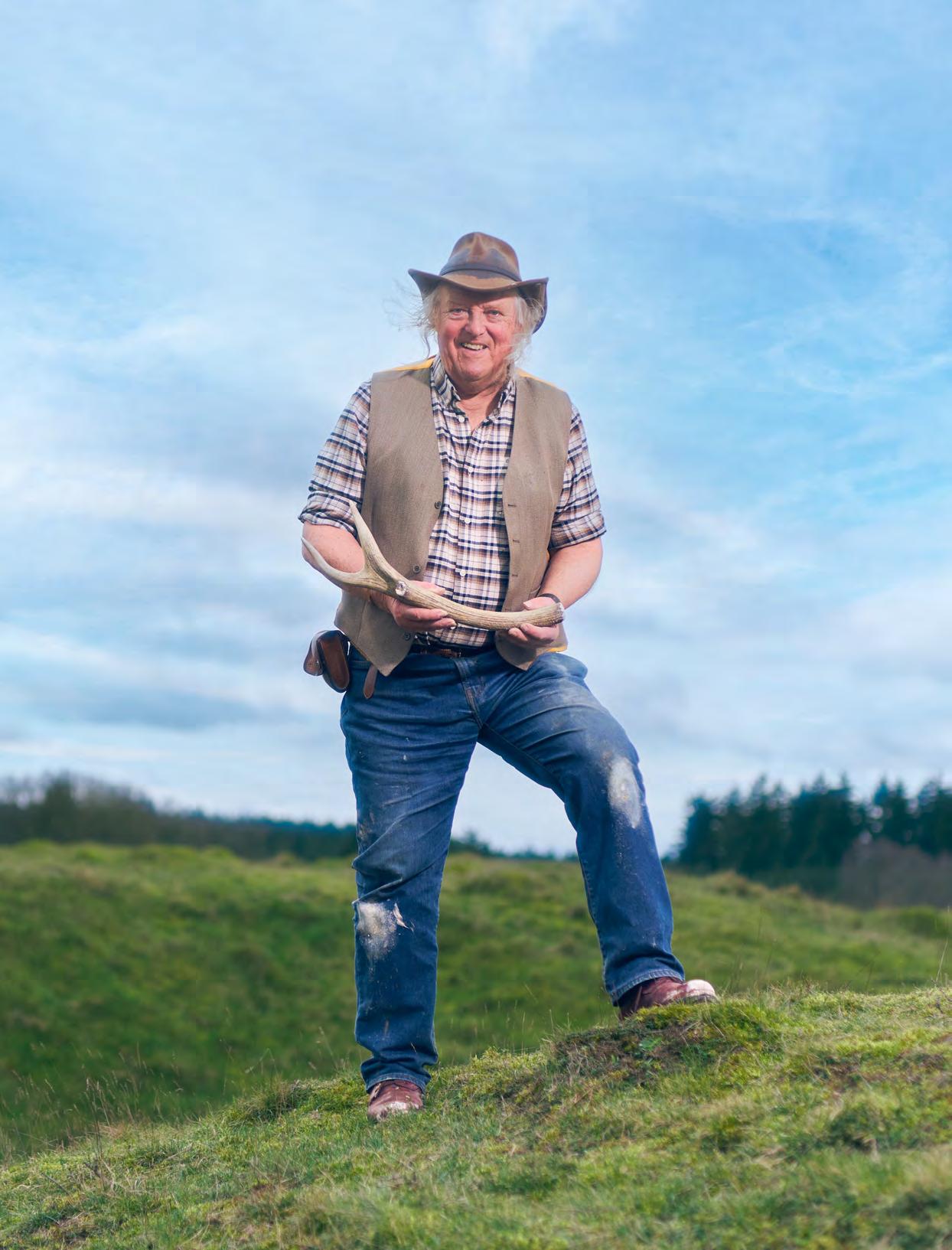
‘Grime’s Graves is a wonderful site and a testament to the skills of the Neolithic people who lived and worked here’


TREASURES OF BURGUNDY & PROVENCE
Discover the cultural & natural splendours of the Rhone & Saone aboard the MS Camargue – 24th June to 1st July & 15th to 22nd October 2025


Our relaxing seven night river cruise along the Rhone offers a passage through history past great architectural treasures, through some truly wonderful scenery and an everchanging countryside dotted with cypress, umbrella pine and vines. You can discover the natural and historical wonders of this corner of France through the interesting onboard lectures and the included guided shore excursions. There will also be ample time spent on board sailing, allowing you to appreciate the wonderful scenery and absorb the subtle changes in landscapes along the river. There will be the opportunity to explore France’s gastronomic capital Lyon and visit Avignon, the great City of Popes and the impressive Roman amphitheatre at Arles. For lovers of the natural world we will visit the Camargue Natural Park area, located south of Arles between the Mediterranean and the two arms of the Rhone River delta, where we can witness the stunning scenery and wildlife including pink flamingos and the famous white horses. All this will be accomplished with ease from the comfort of the delightful 100-passenger MS Camargue.
MS CAMARGUE accommodates just 100 passengers in comfortable and well-appointed cabins, all of which are attractively furnished and feature cable TV, safe, hairdryer, individual air-conditioning and heating controls, ample storage and a dressing table. Cabins on the Main Deck feature large picture windows which can be opened and those on the Upper Deck feature French Balcony style sliding windows. The spacious and elegant public areas include the lounge on the Upper Deck which is a relaxing environment in which to socialise and enjoy a drink from the bar. The elegant restaurant seats all guests in one unassigned seating and the cuisine on board features delicious local and international dishes. There is also a spacious sun deck on board with comfortable deck furniture, which is the perfect place to relax whilst cruising and appreciate the passing scenery. The friendly onboard staff will provide you with excellent service and do much to contribute to your enjoyment throughout your journey. The atmosphere on board is relaxed and informal and a daily briefing by the Cruise Director will provide you with information on the next day’s activities. Expert English speaking guides will accompany you on the included excursions and you will also be accompanied by a Guest Speaker who will provide entertaining and informative talks.






THE ITINERARY IN BRIEF
Day 1 London to Lyon, France. Fly by scheduled flight. Upon arrival transfer to the MS Camargue and embark.
Day 2 Lyon. There will be a choice of tours this morning as we explore Lyon. Our city tour starts with a stop at the Fourviere Basilica where we can take in the breathtaking views and in the old town, a walking tour will discover the “traboules”, types of passageways that are typical of the city. Alternatively, join a food walking tour of this “Gastronomic Capital” which stops at several eateries to taste the local cuisine. We will return to the ship for lunch and enjoy a leisurely afternoon on board as we cruise to Macon.
Day 3 Macon & Cluny Abbey. From our berth in Macon we have a choice of excursion this morning. Maybe visit Cluny Abbey which was founded in 910 by William the Pious. The abbey was under the direct protection of Rome and its abbot was granted the role of mediator between the political leaders and the pope. This ancient Benedictine Abbey extended a widespread influence on all of Medieval Europe. Alternatively, spend the morning in the charming Burgundy town of Macon which has a wide range of striking monuments and beautiful old mansions in the old town. Return to the MS Camargue for lunch as we sail this afternoon.
Day 4 Vienne. We will spend this morning in the fine Roman town of Vienne, beautifully located in the Rhone Valley and surrounded by hills. On our walking tour, we will learn about its Roman era with a visit to the Temple of Augustus and Livia and the Roman theatre which was one of the largest in the Roman Empire with a capacity for 13,000 spectators. Our final visit will be the Romanesque-Gothic Cathedral St Maurice. Relax on board this afternoon as we continue our journey south.
Day 5 Avignon & Arles for The Camargue. Avignon, the great City of the Popes boasts a number of splendid museums, churches and palaces. Our guided walking tour will include the Palais des Papes, one of the wonders of Provence and the largest and most important Medieval Gothic buildings in Europe. We will also visit the Cathedral and have time to wander in the Place De L’Horloge which is built on top of the Roman Forum and the heart of Avignon.
During lunch on board, we sail the short distance to Arles from where we make our way to the Camargue. Admire the scenery which is comprised of rivers, marshes and ponds, and see the pink flamingoes, black bulls and the famous, indigenous Camargue horses. We will see the renowned salt and rice fields and also also visit a manade (bull breeding farm) and learn about the work of a manadier as we watch a demonstration of how they work with the animals they raise. This evening we will enjoy some Provencal entertainment on board as we moor overnight.
Day 6 Arles & Viviers. Spend the morning exploring Arles. A UNESCO World Heritage Site, Arles sits on a low hill where the Rhone river branches in two parts to the sea. The town dates back to the 7th century BC and was a major Gallo-Roman city. The Roman sites are unique in that they are integrated into the houses and buildings of the town. During our walking tour we will see the huge amphitheatre and the former Cathedral of St Trophime, a Romanesque Basilica constructed in the 12th century. Afterwards we drive to a farmhouse in nearby Tarascon to learn about the cultivation of olives and a tasting of the famous Provencal olive oil. We will re-embark in Avignon where the ship will have sailed to meet us and have lunch on board as we sail to Viviers. Viviers has been a residence of bishops since the 5th century. This small town is like an open-air museum where on an evening walking tour we will find France’s smallest cathedral, the House of Knights with a superb Renaissance façade and the Tower of St Michel.
Day 7 Tournon. Spend the morning cruising to Tournon a pretty town located in the heart of the Rhone Valley. A walking tour will include the Chateau de Tournon, a castle dating back to the 16th century which is now a museum and where there will be the opportunity to discover the permanent collection on display which highlights the history of navigation on the Rhone river. This imposing castle was built on a high granite rock overlooking the town and was the domain of the Counts of Tournon. At the foot of the castle, enjoy a pleasant walk along the streets and alleys of the historic centre which will take you back to the Middle Ages. Our visit will end with a tasting of local food and wines.
Day 8 Lyon to London. Disembark this morning and transfer to the airport for our scheduled flight to London.


PER PERSON


ANNECY PRE-CRUISE EXTENSION
If you would like to spend some time in France’s Haute-Savoie region before embarking the MS Camargue we offering a three night extension in the charming lakeside city of Annecy. Full details can be viewed online.

PRICES & INCLUSIONS
Special offer prices per person based on double occupancy start from £2595 for a Category 3 cabin.
WHAT’S INCLUDED:
Economy class scheduled air travel • Seven nights aboard the MS Camargue on a full board basis
• All-inclusive drinks from 10am to 11pm daily
(please note premium brands & sparkling wine are not included) • Shore excursions • Cruise Director
• Tour Manager • Guest Speaker • Gratuities
• Transfers • Port taxes • Airport taxes.
NB. Ports and itinerary are subject to change. All special offers are subject to availability. Travel insurance is not included in the price. Our current booking conditions apply to all reservations.

Every one’s a winner
From Neolithic burial chambers to a Cold War bunker, we reveal our record-setting sites to visit with your membership
WORDS OLIVER HURLEY ILLUSTRATIONS JACK DALY
800
The number of years since the east end of the abbey’s church was spectacularly remodelled

Kit’s Coty House
Thanks to stunning views across the North Downs and Medway Valley, and the enigmatic, ancient remains themselves, there is something quietly impressive about Kit’s Coty House. Together with its neighbour, Little Kit’s Coty House, the sites represent the remains of two megalithic ‘dolmen’ burial chambers, dating from the early Neolithic period of about 4000–3000 BC. They were used as communal
5,000 to 6,000
The age in years of Kit’s Coty House
burial places by Britain’s earliest farming communities and represent some of the country’s oldest surviving prehistoric monuments. Kit’s Coty House is the larger of the two monuments and comprises three upright stones and a capstone. Both sites can be found off the North Downs Way National Trail in Kent. Just don’t ask who or what Kit’s Coty is – the origins of the name remain a mystery.
Rievaulx Abbey
With its beautiful location in a tranquil wooded valley, it’s easy to imagine the quiet life of a monk at what was one of England’s most powerful Cistercian monasteries. Indeed, you’d be hard-pressed to conjure up a more picturesque or peaceful location. ‘It is a place that stimulates the mind and nourishes the spirit,’ agrees senior properties historian Dr Michael Carter.
The stately ruins are complemented by a welcoming café, site museum and audio tour. Founded in 1132 by 12 monks from Clairvaux Abbey in France, Rievaulx was the first Cistercian monastery in the north of England. By the 1160s, a peak of around
640 monks were living here. Monastic life here came to a dramatic end in 1538 during Henry VIII’s Dissolution of the Monasteries – but there is still plenty to capture visitors’ imaginations today.
‘The more you look, the more you’ll see,’ says Carter. He cites the imposing east end of the church as ‘one of the glories of English Gothic architecture’. Other parts to look out for include the 14th-century altars in the nave, and the remains of the 13th-century shrine built for St William’s relics. ‘What survives at Rievaulx,’ says Carter, ‘can be counted among the most important monastic remains in England, if not Europe.’

Kenwood
For fans of art, there is perhaps no better place to visit than Kenwood in London: at any one time, about 3,000 objects from its collection are on public display, from tiny items of jewellery to enormous sculptures in the landscape. But the stately home is best known for its world-class collection of around 225 paintings, dating from 1560 to 2021.
‘Kenwood has some very generous people to thank for the wonderful collections, beginning in 1927 with Edward Cecil Guinness, 1st Earl of Iveagh, who left the villa, estate and part of
his art collection to the nation,’ says Kenwood’s curator of collections and interiors Louise Cooling. Kenwood is also home to The Suffolk Collection, which was amassed over 400 years by generations of the earls of Suffolk and Berkshire. Works that should be on every visitor’s must-see list include The Guitar Player (c.1672), one of only 36 known paintings by Johannes Vermeer; Hampstead Heath With Pond and Bathers (1821) by John Constable; and Monolith Empyrean (1953), a huge sculpture by Barbara Hepworth.
MOST CONTEMPORARY SITE
York Cold War Bunker
Not only is York Cold War Bunker English Heritage’s most contemporary site, it is also its most spine-chilling. The bunker was built in 1961 to monitor fallout in the event of a nuclear attack, and you can still see the original rooms that would have been used by the Royal Observer Corps. ‘Largely untouched since its door was locked in 1992, visitors enter an extraordinarily powerful space,’ says senior collections curator Kevin Booth. ‘Guided tours bring you face-to-face with the reality of nuclear conflict and the stories of those who would plot the end of the world.’

OLDEST CASTLE
Pevensey Castle
First built as a Roman Saxon Shore fort in the 4th century, Pevensey Castle was fortified by the Normans when they landed here in 1066. Today, you can explore the castle’s battlements and dungeon, see a recreated 1940s commander’s office, and discover tales of sieges and royal prisoners.
BEST PRESERVED IRON AGE SETTLEMENT
Chysauster Ancient Village
Peer along a mysterious underground passage known as a fogou and you’re transported back to the world of the people who once lived in this remarkably well-preserved RomanoBritish settlement. These types of stone-walled tunnels are found only in the far west of Cornwall and their exact purpose is still not known. Elsewhere, you can explore the remains of ancient stone houses laid out along a village street that was originally occupied almost 2,000 years ago, and spot a variety of birds and wildlife. Walk to the top of the site to take in a breathtaking view that stretches down to the coast.

MOST BESIEGED CASTLE
Norham Castle
This important medieval border castle in Northumberland was once called ‘the most dangerous place in the country’ – and it’s easy to see why. Between 1138 and 1513 it was besieged by the Scots nine times, making it English Heritage’s most besieged castle (a title, we should add, that it shares with Carlisle Castle in Cumbria). The stronghold lies on the river Tweed, historically the border between Scotland and England, and remains one of the finest sights in the border country. Look out for the remains of the castle’s Great Tower and massive towered bailey walls, which were destroyed by James IV’s heavy artillery in 1513, shortly before his defeat at Flodden Field.
The total number of sieges endured by Norham Castle
EAST SUSSEX
BIGGEST SITE
Hadrian’s Wall
Stretching for 73 miles across some of the most dramatic countryside in England, Hadrian’s Wall remains the most famous frontier of the Roman Empire. Built under the orders of its namesake, Emperor Hadrian, it took the Roman army between four and ten years to construct.
‘The best way to experience Hadrian’s Wall is to see it at several different places,’ says properties historian Andrew Roberts. ‘The changing terrain makes each section different, from the rivers and gently rolling hills in the east and west,
to the high windswept crags of the central sector.’
At Corbridge Roman Town in Northumberland, you can experience a time capsule of life in a bustling Roman town, and see the armour uncovered in the Corbridge Hoard (see page 44). Nearby is Chesters Roman Fort, at which the cavalry unit responsible for patrolling the valley of the river North Tyne was stationed, with its museum of Roman finds, remains of the underground strongroom and well-preserved bathhouse.

A further eight miles to the west is Housesteads Roman Fort, the remains of which still provide a sense of what life was like for the 800 soldiers once stationed there.
But perhaps the best place to introduce your family to the history of the Wall is Birdoswald Roman Fort in Cumbria. ‘It has a handson family visitor centre and an adventure game you can play in the fort,’ says Roberts. ‘It’s also a great place to take a gentle walk along a well-preserved section of the Wall itself.’
The total length in miles of Hadrian’s Wall from coast to coast
TYNE & WEAR, NORTHUMBERLAND & CUMBRIA
LUNCH IS ON US
Your exclusive members’ kids eat free offer is back to help you save money as your little ones refuel during family days out this summer
o help you get more value out of your family adventures this summer, we’re offering free children’s lunch bags for members at 30 participating English Heritage cafés nationwide. These include cafés at many of our most popular sites, including Stonehenge in Wiltshire, Tintagel Castle in Cornwall, Dover Castle in Kent, Kenilworth Castle and Elizabethan Garden in Warwickshire, Bolsover Castle in Derbyshire, Beeston Castle and Woodland Park in Cheshire, and Belsay Hall, Castle and Gardens in Northumberland.
This member-exclusive offer runs until 31 August 2024. To qualify, you need to spend £10 or more in the café and show your membership card to receive up to two free kids’ lunch bags. Each bag contains a sandwich, crisps, a drink, fruit, biscuits and crayons to complete the activities on the lunch bag*.
What’s more, if you’re a member in your second year (or longer), you can also use your loyalty discount to get an extra 10% off your café bill.
EXTRA SAVINGS
Use your members’ loyalty discount for an additional 10% off your café bill

Wherever your summer travels take you, be sure to take advantage of all the other money-saving benefits included with your English Heritage membership. These include free access to our historic sites for you and up to six children, free or reduced entry to our national events, access to an exclusive members’ events programme, plus free or discounted entry to a range of associated attractions across the British Isles and overseas. These include the sites cared for by Cadw in Wales and Historic Scotland. For full terms and conditions for our members’ kids eat free offer, including a list of all participating cafés, go to www.englishheritage.org.uk/ kids-eat-free

‘Wherever your summer travels take you, take advantage of all the other money-saving benefits of your English Heritage membership’

Register in our new Members’ Area to enjoy all your benefits
Make sure you’re getting the most of being a member by registering for the new Members’ Area of our website, where you can view and manage your membership. The Members’ Area is also packed with exclusive content to inspire your adventures, including a new 2024 summer planner, with ideas for things to do and blockbuster events to enjoy during the holidays. We are grateful for the generous support of Bloomberg Philanthropies, who have made the new Members’ Area and wider Customer Relations Management system possible.

Stay where history happened




This advertisement is issued by HPB Management Limited (HPBM), the main UK agent and the property manager for HPB, authorised and regulated by the Financial Conduct Authority, registered at HPB House, Newmarket, Suffolk, CB8 8EH. HPB is available exclusively through HPBM. HPB is issued by HPB Assurance Limited (HPBA) registered in the Isle of Man and authorised by the Financial Services Authority there. HPBM promotes only HPB and is not independent of HPBA. Holders of policies issued by HPBA will not be protected by the Financial Services Compensation Scheme if the company becomes unable to meet its liabilities to them but Isle of Man compensation arrangements apply to new policies.
Manoir du Hilguy, Brittany St Brides Castle, Pembrokeshire
Sibton Park, Kent
Stigliano, Tuscany


“In my experience, HPB has all the ingredients of a perfect holiday”
2001




For over 40 years, the Holiday Property Bond (HPB) has been discovering unique properties with a fascinating past and then carefully restoring and renovating them.
From a Queen Anne Grade II* listed country house in the heart of Kent’s serene North Downs to a turreted Victorian mansion on the banks of Loch Achray in the Scottish Highlands, HPB is the custodian of over 30 historic properties throughout the UK and Europe that have been converted into exclusive holiday homes.
Become a Bondholder and you’ll be able to discover the fascinating history of these beautiful locations. Not only that, your holiday booking power will be reissued to you every year, so you can holiday in history time and time again.
Find out more – request your free brochure today
As an English Heritage member, HPB will give
a bonus of 5% extra
entitlement
Exclusive holidays for life An initial payment from £5,000 and a quarterly fee of under £38 (that is around £150 a year), which can increase in line with but not exceed the Retail Price Index Excluding Mortgage Interest (RPIX), gives you access to all HPB’s holiday homes. For each HPB holiday, you will pay a no-profit user charge covering only property running and maintenance costs and use of on-site facilities. The average charge is the same throughout the year, and for a studio is around £360 a week and £540 for a two bedroom property. Larger properties are also available. After an initial charge of 25% your money is invested in a fund of holiday properties and securities. The fund itself meets annual charges of 2.5% of its net assets at cost, calculated monthly. Your investment return is purely in the form of holidays and, as with most investments, your capital is at risk. You can surrender your investment to the company after two years or more (subject to deferral in exceptional circumstances) but you will get back less than you invested because of the charges referred to above, as well as other overheads and changes in the value of the fund’s properties and securities.
Tigh Mor Trossachs, Scottish Highlands
Blore Hall, Peak District
Buckland Court, Cotswolds
Sue Barker HPB Bondholder since
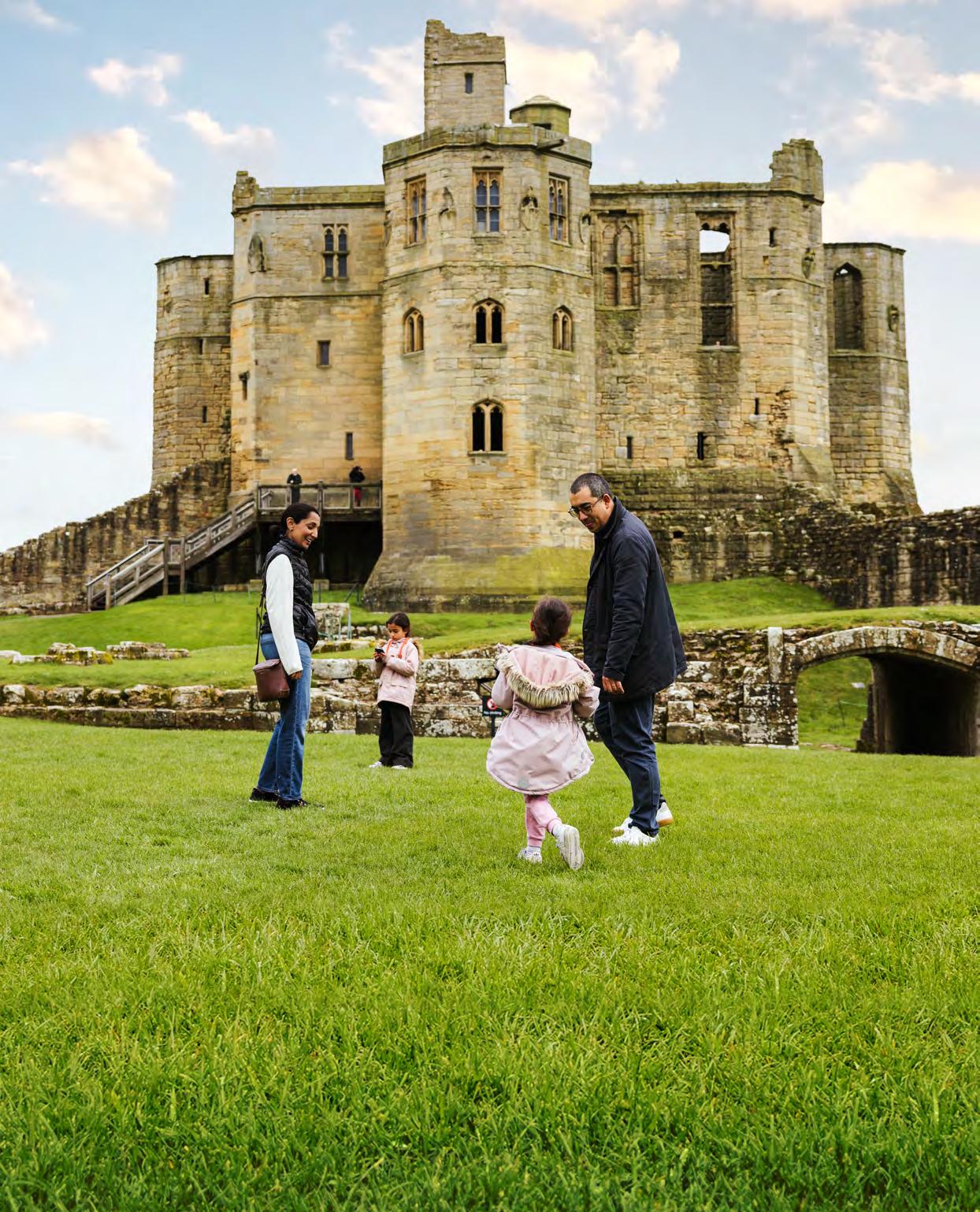

Ramparts and raiders
Heading north for a family adventure on the wild Northumberland coast, Monisha Rajesh finds extraordinary fortresses and a supernatural spiritual retreat
PHOTOGRAPHS JOANNE CRAWFORD
Crouching in the darkness, feeling my way along stone that was damp to the touch, I heard a small gasp, followed by coos and flaps as a pigeon took off through the window. ‘Look, there are eggs!’ my eldest daughter said, as her sister let go of my hand and clattered up the passage to inspect the nest tucked into a crevice. Clambering out and into the daylight, I stood up to find the girls had run across the Great Hall and disappeared into another pocket of the Great Tower, their shouts echoing between the stone walls of this 14th-century maze and its modern-day thrills.

Facing page Monisha and her family explore Warkworth Castle as part of their Northumberland tour
Above An interactive family trail guides visitors around the site Top right Monisha’s daughters make their way down from the castle walls

We were exploring Warkworth Castle, one of medieval England’s most extraordinary fortresses and, from the 14th to the 17th centuries, the favoured residence of the powerful Percy family – once the earls of Northumberland. Together with my husband and two daughters, aged seven and five, I’d decided to make the journey from London to give them a taster of the north. Just shy of fifty years ago, my parents had arrived in England from south India, settling in South Shields, thirty or so miles down the coast. They’d moved on to Norfolk before I was born but had often talked about taking day trips around Northumberland’s historic ruins and I’d longed to see them.
From our cottage, near the village of Belford, we set off after breakfast on the half-hour drive. Golden rapeseed, glossy cows and pheasants flanked our route, my daughters thrilled by the countryside views livening up their games of I Spy.
With audio guides in hand, the girls worked their way around Warkworth’s new family trail, peering into wells, discovering keys in the brickwork and listening to tales of great feasts being prepared in the kitchens, shouting at us to catch up. Before we set off, I was worried they’d drag their feet, but they were off like dogs unleashed, pushing buttons, smelling moss on the walls and stroking sculptures in the chapel. For my part, I was taken back 25 years to studying the Percy family at school, wishing I’d had such a tangible experience to push my grades up a notch.
Before setting off to the next stop at Dunstanburgh further up the coast, we gathered at the top of a grand staircase and looked out across the stained ramparts to where the river Coquet glistened like a silver belt. I paused and imagined being a lookout for invaders, when my eldest
TAKE ME THERE
Start planning your own Northumberland adventure
Lindisfarne Priory
Dunstanburgh Castle
Northumberland
Warkworth Castle
Address Castle Terrace, Warkworth, Northumberland, NE65 0UJ By car In Warkworth, 7½ miles south of Alnwick on A1068 By bus Arriva X18 Newcastle to Alnwick and Travelsure 472 By train Nearest station Alnmouth (3½ miles)
Dunstanburgh Castle
Address Dunstanburgh Road, Craster, Alnwick, Northumberland, NE66 3TT (for parking, use NE66 3TW) By car From B1339,
Warkworth Castle
8 miles north-east of Alnwick, take Windyside Hill turning to Craster By bus Arriva service X18 and Travelsure 418, alighting at Craster By train Nearest stations Chathill (7 miles) and Alnmouth (8½ miles)
Lindisfarne Priory
Address Holy Island, Berwick-UponTweed, Northumberland, TD15 2RX By car On Holy Island, only accessible at low tide By bus Perrymans service 477 from Berwick By train Nearest station Berwick-upon-Tweed (14 miles)

Bottom left Spotting dolphins in the surf Right An interactive sculpture at Warkworth Top right On the approach to Dunstanburgh Castle Middle right Scampi and chips in Craster Bottom right Playing hoopla in the grounds of Dunstanburgh Castle
daughter pointed out to Coquet Island off the coast of Amble. ‘Is that Newcastle?’ she asked.
‘Nooooo,’ her sister replied, ‘this is an old castle.’
Canopied by cherry blossom, we wound north, rising and dipping along lanes lined with scarpering grouse and matted sheep, arriving halfan-hour later at the fishing village of Craster. Here, under the watchful eyes of gulls, we stopped for lunch at the Jolly Fisherman, munching through boxes of scampi and chips as wet dogs snuffled around our feet. Fuelled for the next adventure, the girls ran down towards the harbour, the wind whipping their hair into knots as they inspected a pile of lobster pots tethered with rope and rock pools slicked with slime.
In the distance, we could just make out the towers of Dunstanburgh Castle through the haze and set off on the 1.3-mile coastal trek along the edge of working farmland to see the ruins. Thick bushes of mustard-yellow gorse ran the length of the walk, their petals sending the scent of warm coconut into the air as suspicious sheep watched the girls collect tufts of wool from the grass. As the tide was far out, we paused to pick through piles of shells littered with soft sea glass and debris caught on barbed wire, as though a doll had just hung up her laundry.
Built in the early 14th century on a remote headland not far from the Scottish border, Dunstanburgh Castle was far more wind-battered and bruised than Warkworth, a shell of its former self with its twin-towered keep exposed to the elements and its walls scattered and pockmarked. But up close its brickwork was still a thing of beauty, salt crystals patterned across its ridges, sequinned with tiny snails that had taken up home. Balancing on a knife-edge drop, overlooking a creamy curve of coastline, we spotted a couple of razorbills, wishing we’d brought binoculars.
Home to nesting guillemots, kittiwakes and fulmars, this was a peaceful place for the girls to run and for us to roam, until a game of hoopla caught us off guard, the calm turning to fiery competition that only ended when the keeper wanted to lock up for the night. On the walk back, the wind picking up and the waves whipping into peaks, we stopped to take in the might of the North Sea. And there, in between the fizz and foam was the outline of fins from




‘This was a peaceful place for the girls to run and for us to roam, until a game of hoopla caught us off guard’
‘At 10am we drove across the causeway, sandy banks running up to the road, water pooling around swathes of seaweed’


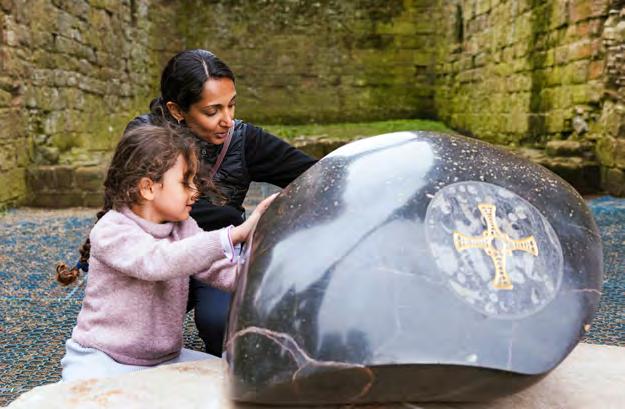

Facing page, left Driving to Lindisfarne Middle left Enjoying an ice cream Bottom left A monument to St Cuthbert Bottom right A 9th-century grave marker at Lindisfarne This page, right Fenwick Lawson’s statue of St Cuthbert Below Walking near the abbey ruins
a pod of dolphins looping in and out. ‘Mummy, are they dolphins? Are they actually?’ asked my eldest daughter.
‘Or porpoises,’ I said.
‘Wow, that is the best thing ever,’ she replied, her eyes shining as two more popped into view. That night, a stone’s throw from our cottage, we had dinner at the wonderful Purdy Lodge. The fresh air and running around had reduced us to a yawning quartet in search of the comforts of belly pork and black pudding salad, followed by homemade steak-and-ale pies.
The following morning, after a breakfast of fried eggs foraged from an honour box on the corner of our lane, we set off to the Holy Island of Lindisfarne. Here, checking the time of the tidal crossings is of paramount importance so you don’t end up submerged in the rising waters. At around 10am we drove across the causeway, sandy banks and rivulets running up to the road, water pooling around great swathes of seaweed dumped like piles of rubber gloves. Off the other side, we parked and walked up past cottages climbing with roses, shops selling Celtic jewellery, and an old red phone box – the first the girls had ever seen.
Home to two medieval saints named Aidan and Cuthbert, who between them founded and then


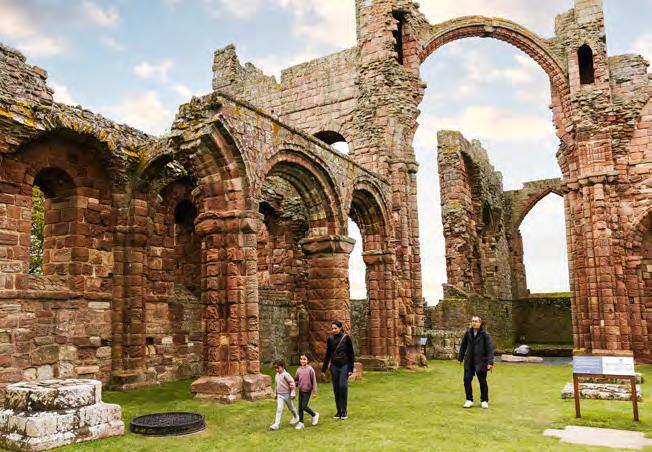
led a religious community from AD 635–686, Lindisfarne felt awash with the supernatural. It was in the air, swirling around the graveyard, and I could feel why people had been drawn into its aura for centuries.
Once the location of an Anglo-Saxon monastery destroyed by Viking raids, a priory was then built on top, the remnants of which defied belief: patterned with arrowheads and engraved with dots, the brickwork revealed exquisite stonemasonry that had somehow stood the test of time. Thrilled by a task, the girls found the discovery trail and tore back and forth around the grounds, feeling the stonework, writing their names in the runic alphabet and listening for seals – a colony of which were bobbing around in the waters. After a quick stop at the Crown & Anchor for hot haggis fritters and a pint, we wandered around the new museum, where the girls designed their own runes on interactive screens, and we sampled bottles of sweet local mead.
Ice creams in hand, we made our way out of the village, grateful for a weekend of learning and adventure. As the tide drew out, the cars lined up and we sped back across the causeway throwing a last look at Lindisfarne. It had taken me more than forty years to explore this corner of the country’s history and, as the late afternoon sun lit up the landscape, I could feel the spirit of Holy Island thrumming quietly behind us.
Recent analysis has shown that some of these decorative copper studs were silvered
Secrets of the Corbridge Hoard at Corbridge Roman Town, Northumberland
WORDS DR FRANCES M c INTOSH
Sixty years ago, on 17 July 1964, archaeologists excavating at Corbridge Roman Town came upon the corner of an iron-bound wooden chest packed full of objects. They had no idea just how important this discovery was.
Now known as the Corbridge Hoard, the chest most famously contained parts of six suits of lorica segmentata armour. However, there were also 46 spearheads, a range of tools (a saw, pickaxe, chisels, shears and knives) and personal items such as a tankard, glass gaming counters and wooden writing tablets. The wood and other organic materials have survived due to the burial conditions, with the iron corrosion leaching into them.
Buried beside the road next to the headquarters of the fort around AD 122–138, the hoard is thought to be the stock of a soldier armourer. The suits of armour could be broken down to replace single segments as required, and the spearheads were awaiting wooden shafts to be fitted.
But why was this material buried and never recovered? Soldiers moved around regularly, so perhaps the soldier was sent on a short trip, but couldn’t take the material with him and buried it to keep it safe, assuming he would return. He didn’t and we will likely never know why.
See it for yourself
To see the hoard or join us for an event to celebrate its discovery on 20–21 July, go to www.english-heritage.org.uk/corbridge

The shoulder guard allowed for good freedom of movement by the soldier
The copper alloy fittings have corroded to a green colour

Remains of the leather straps that held the segments together can still be seen (the light orange squares)
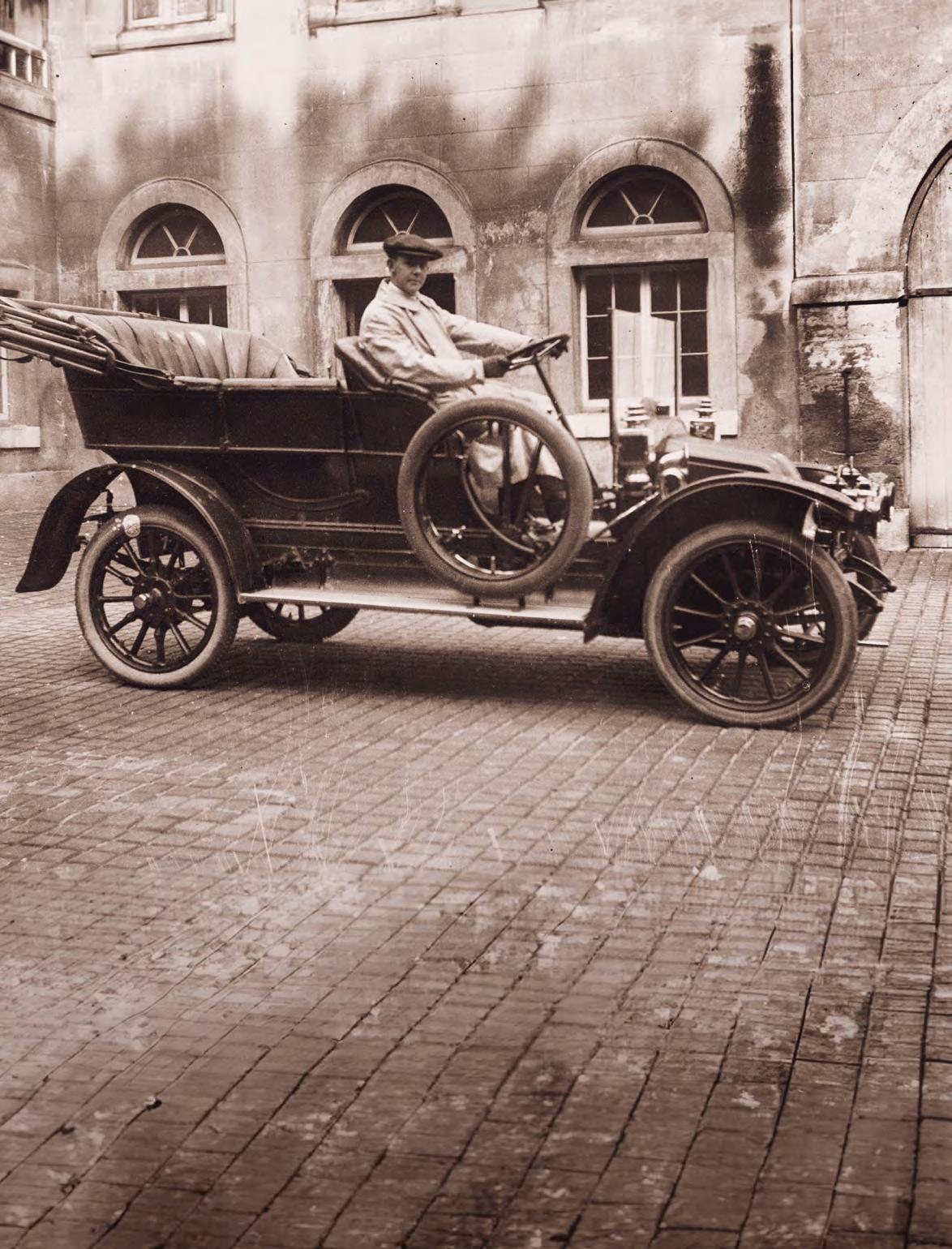
With access to all of today’s modern conveniences, it’s hard to imagine the army of servants employed to ensure the smooth running of 19th-century country houses. But, as Dr Andrew Hann and Eleanor Matthews reveal, a dizzying array of domestic staff played a vital role during the Victorian era
In 1851, over a million people were employed in domestic service across the country, and this number continued to rise over the decades that followed. The majority of these people were women, many working as maids in middle-class households. Service life was often a solitary experience marked by relentless drudgery.
Wealthier country-house owners employed an army of servants, each with clearly demarcated roles, and they were often restricted to particular parts of the house and grounds. The kitchen maids, for example, rarely strayed far from the service wing. Among the servants themselves there were strict codes of behaviour, with higher-ranking servants treated deferentially by those lower down the pecking order.
Facing page Alfred Edwards, the valet and chauffeur for Charles Thellusson at Brodsworth Hall, early 20th century Right Hannah Mackenzie (left), housekeeper at Wrest Park 1912–15, with Wrest’s cook, Mrs Geyton Top right Martin Shillitoe, butler at Brodsworth Hall in the 1880s
The upper servants
At the top of the pyramid in the house was the housekeeper, who was in charge of all the female servants apart from the lady’s maid and governess. The housekeeper was responsible for the daily running of the home, keeping the accounts and supervising the linen cupboard. Housekeepers were well paid: Mary Withers, housekeeper at Audley End in 1871, earned £50 per year, compared with £15–£20 for a housemaid.
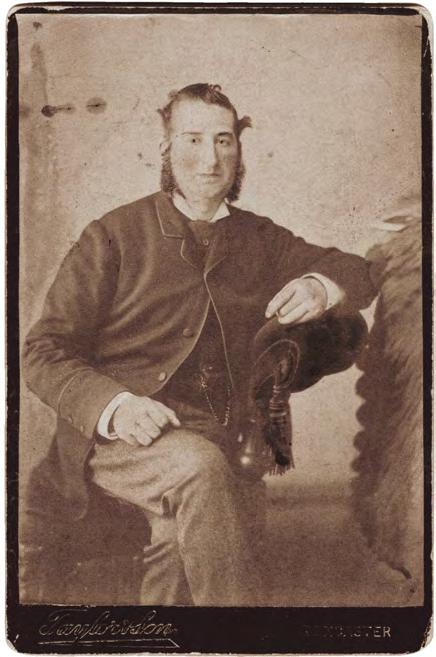

The butler was the highest-ranking male indoor servant in most Victorian country houses, and was similar in status to the housekeeper. He was responsible for looking after the wine cellar and silverware, and supervised the other male indoor servants. Always smartly dressed in black dress coat and white tie, he welcomed guests at the
‘Martin Shillitoe was one of the Thellusson family’s butlers at Brodsworth Hall, working his way up from being a footman in the 1870s to butler in 1881’
front door and waited at every meal. Martin Shillitoe was one of the Thellusson’s butlers at Brodsworth Hall, working his way up from a footman in the 1870s to butler in 1881. The valet was the personal servant of the master of the house, while the lady’s maid attended to the mistress. Both had a close relationship with their employers, from dressing them to dealing with correspondence. Kate Bott came to Brodsworth Hall as lady’s maid to Constance Thellusson in 1906. Even after leaving to get married, Kate and her mistress remained friends and corresponded throughout the rest of their lives.
The cook was in charge of the kitchen. Their duties varied depending on the size of the household. Most Victorian cooks were women –Avis Crocombe, for instance, was cook at Audley End from 1881–84, preparing meals for Lord and Lady Braybrooke and up to 40 people when they had visitors. The royal kitchens at Osborne were on a different scale. Around 10 kitchen staff accompanied Queen Victoria when she visited. In 1861, this included third master cook Charles Jungbluth, second yeoman of the kitchen George Desaulles, and pastry cook Alphonse Gouffé.
The lower servants
While the upper servants supervised the household, the lower servants did most of the hard work. Working under the cook in the Victorian kitchen were usually a number of kitchen maids and scullery maids. At Witley Court in Worcestershire, the Earl and Countess of Dudley had four kitchen maids in 1861, whereas at Belsay Hall in Northumberland, the household was a little smaller, with only one kitchen maid and a scullery maid.
Every country house needed a laundry maid (or maids) to clean and launder the mountain of dirty clothes, bed linen and towels produced when the family was in residence. At Audley End in 1871, the three laundry maids, Sarah Walker, Ellen Yates and Elizabeth Goddard, were kept fully occupied washing, starching, mangling and ironing for Lord and Lady Braybrooke.
Housemaids were responsible for keeping the main rooms of a house tidy, clean and warm. It wasn’t unusual for hard-working housemaids to rise through the ranks, provided they didn’t marry. Jane Langton came to Brodsworth around 1895 as a

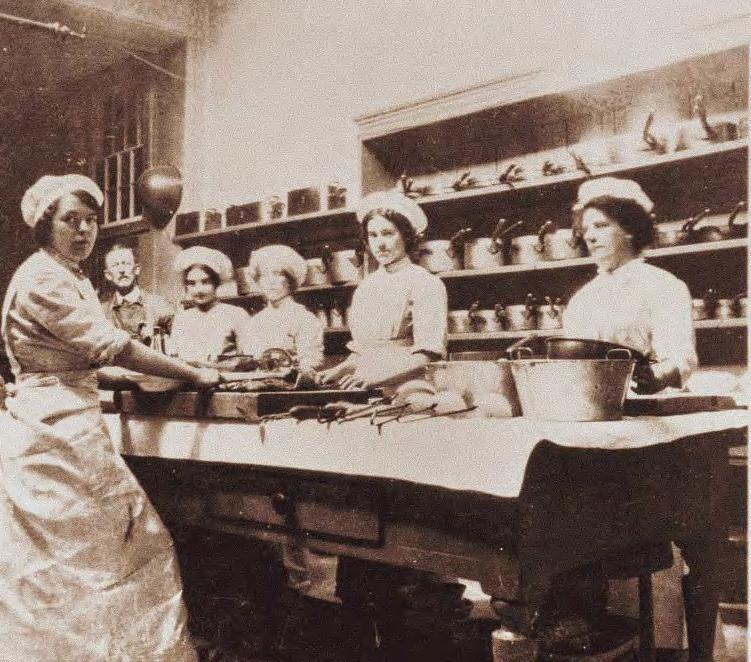
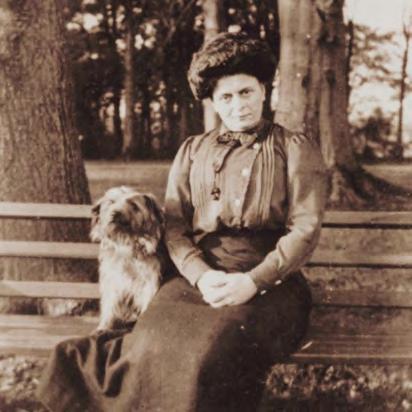
housemaid, later taking up the role of lady’s maid. Finally in 1916 she became the housekeeper, holding sway at the hall for a further 20 years.
In the nursery, nurses and nurse maids looked after children up to the age of five. They were usually teenage girls from the local area and daughters of estate workers. Miss Wallace, the governess of Pamela Grant-Dalton (daughter of Charles Grant-Dalton, Brodsworth Hall’s then owner), moved with the family from Hampshire to Brodsworth in the 1930s. Although Pamela remembered Miss Wallace as being ‘a perfectly super woman’, she acknowledged that her role was difficult as she was neither part of the family nor a servant.
The outdoor servants
It was common practice for landowners to employ an estate steward or land agent. They were skilled professionals rather than servants, often with legal training, and were expected to run the estate as a
FIND OUT MORE
Read a longer version of this article at www.englishheritage.org.uk/jobsin-a-victoriancountry-house

‘The head gardener also had to ensure the house was well supplied with fruit, vegetables and cut flowers throughout the year, a difficult task anywhere in England’
successful business. They were also responsible for finding suitable tenants for farms and cottages and collecting rents. Department heads such as the head gardener, head gamekeeper and farm bailiff reported to the steward. The steward could often have quite a grand residence on the estate. When Sir Charles Monck and his family left Belsay Castle for the newly built hall at Christmas in 1817, parts of the castle were remodelled as a more modest home for his steward, Edward Clint.
The head gardener looked after both the pleasure grounds and the kitchen garden. He also had to ensure the house was well supplied with fruit, vegetables and cut flowers throughout the year, a difficult task anywhere in England, but particularly so in the north. Talented head gardeners were highly prized and could command

a relatively good salary. John Bryan, head gardener at Audley End in the 1870s, was paid £100 per year. A garden labourer might expect to earn 13 shillings a week – around £30 per year.
Most large estates had a team of gamekeepers responsible for managing land for the benefit of hunting, shooting and fishing. This involved raising game birds and animals, and protecting them from predators and poachers. Amabel, Countess de Grey of Wrest Park often sent sides of venison to family and friends in the 1820s, with details of the number of deer killed carefully recorded by the gamekeeper, Thomas Hill.
Far left Kitchen staff at Wrest Park, 1915 Left (inset) Jane Langton, housemaid, lady’s maid and then housekeeper at Brodsworth Hall from 1895–1936 Above Head gardener George MacKinley (centre) and his team at Wrest Park in 1910 Above right Matthew Talbot Baines, the first resident land agent at Brodsworth Hall, 1892
Victorian country houses couldn’t function without the support of the different roles held by indoor and outdoor staff. Every job formed part of a well-oiled machine to keep houses clean and tidy, people fed and clothed, animals cared for and gardens looking beautiful. These staff were fundamental in maintaining the lifestyle expected by country-house owners. Many of the areas where staff worked can be explored at English Heritage properties today, including the butler’s pantry at Brodsworth Hall, the stable block at Audley End or the table deckers’ rooms at Osborne.
Discover more
To learn more about other aspects of Victorian England, from architecture to politics, go to www.englishheritage.org.uk/learn/story-of-england/victorian





With Summer Sale Savings across our entire collection, there’s never been a better time to invest in our luxury fitted furniture. Our wide range of designs include everything from bespoke bedrooms and walk-in wardrobes to hardworking home offices, elegant lounges and indulgent dressing rooms. So whatever your vision may be, our expert designers will help you realise it to perfection. Request a brochure and arrange a FREE design consultation today.


Changing tides
The romantic ruins of Reculver Towers and Roman Fort provide a window into two millennia of shifting history on the Kent coast. Now, a multi-year conservation project is keeping this important landmark standing, finds Gabrielle Jaffe
Ifirst spy Reculver’s towers a good 10 minutes before I arrive. For centuries, the 23 metre-high twin towers of St Mary’s church have dominated the surrounding green pastures and blue waters of Herne Bay on the Kent coast. As the highest building for miles, it has long been used as a navigational marker for seafarers, villagers and, more recently, hikers and cyclists on the popular trail along Kent’s north coast. Now, a fouryear, £1.2 million conservation project has made sure these famous towers continue to stand tall for years to come.
‘Reculver is a scheduled monument of national significance and a landmark that local communities value,’ says national projects manager Deborah Beeson. ‘It’s important to preserve it for future generations.’
When I visit, I think of the generations who stood here before me, stretching back nearly two millennia. Starting at the site’s south-eastern corner, the remaining walls of an early third-century fort transport me to the Roman occupation. Moving west, the outlines of a seventhcentury church remain as relics of the
Christian conversion of the Anglo-Saxons. At the westernmost wall of the church, Gothic arches and grand towers, grafted on the earlier Anglo-Saxon building, propel me forward half a millennium. The towers were built when it was a parish church, its skyline-piercing ambitions mirroring the local community’s wealth. Just south of the towers, and another half millennium on, gravestones from the 18th century stand as testament to a community in decline, as coastal erosion forced the villagers to move away.
‘Reculver is special because it represents the continuity of settlement. At the same time, we see dramatic changes, thanks to the dynamics of the coast,’ says senior properties curator Roy Porter. Reculver’s geography today would have been mostly unrecognisable to the Roman soldiers garrisoned here 1,800 years ago. When I look east, I see an oyster farm and fields. They would have seen the Wantsum, a two mile-wide sea channel that at one time annexed the Isle of Thanet from the mainland. This vast waterway thronged with ships until it silted up during the late medieval period.
‘A glorious hodgepodge of over 20 different types of stone creates a kaleidoscope of grey, red and yellow tones. It’s this rich mosaic of stonework that makes Reculver particularly challenging to conserve’
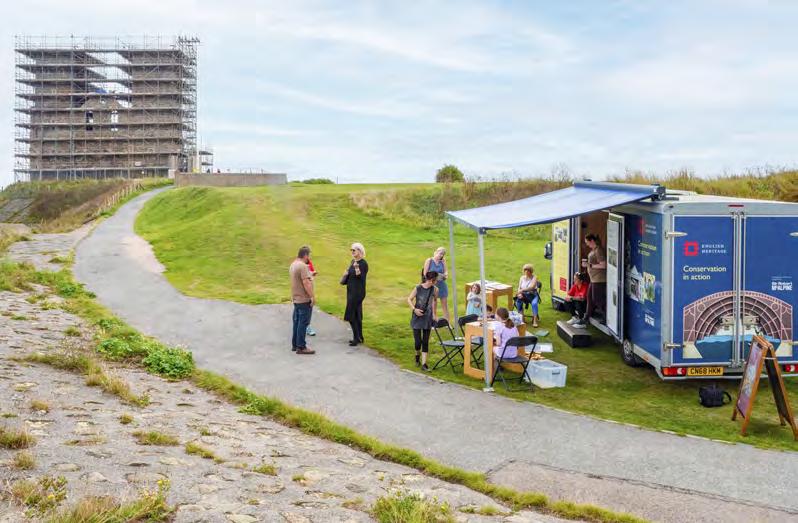
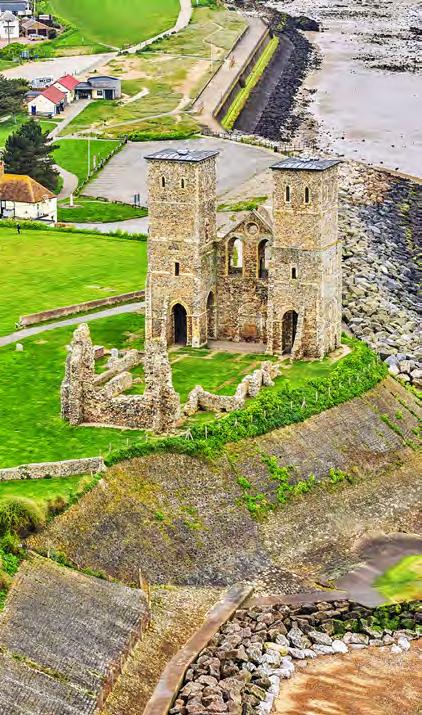
ALL THANKS TO YOU
This project was completed with your support in last year’s coastal conservation appeal
Today, little more than a drainage ditch, this former waterway helps explain why the Romans built here. ‘It was of strategic importance,’ says Porter. Known as Regulbium at that time, this was one of the earliest forts of the ‘Saxon Shore’, built to defend against Saxon raids. ‘Ironically, the harbour is now dry farmland and half of the fort has disappeared into the sea because of coastal erosion,’ says Porter. Before this most recent conservation project began, it would have been hard to see what did remain of the Roman fort. ‘The walls were overgrown with ivy and hawthorn. Red valerian and tree saplings had rooted in,’ recalls Beeson. Now, with the vegetation removed, I can admire the construction of these flint walls.
While Roman Reculver was designed to keep the Saxons out, its next incarnation was designed to bring them into the fold. In 669, half-a-century after Christianity came to Anglo-Saxon Kent with St Augustine, a monastic settlement named St Mary the Virgin was built here.
‘It wasn’t a closed-off monastery but a Saxon minster,’ explains Porter.
Left The conservation in action van gave visitors an insight into the work at the site

‘There was a missionary side. The clergy here would have served a wide stretch of north Kent.’ Nowadays, the church stands at the edge of the cliff. But it was constructed in what would have been the centre of the old Roman fort. ‘This is when the Church was trying to associate itself with the status and authority of ancient Rome. It was not uncommon to find churches established within former Roman perimeters,’ says Porter. As well as the symbolism, there were practical benefits. ‘The Roman ruins provided a ready source of stone. ‘If you look at the lowest level of the church ruins, you see Roman bricks.’
Only a few low-lying walls at the centre of the church’s ruins date back to the Anglo-Saxon period. Much of what is left is from later medieval additions. What we see today is the exposed medieval inner walls. Long gone is the original lime rendering that would have given them a smooth finish. Instead, a glorious hodgepodge of over twenty different types of stone, from flint to reused Roman tile, creates a kaleidoscope of grey, red and yellow tones.
It’s this rich mosaic of stonework that makes Reculver particularly challenging to conserve. ‘We looked stone by stone and found replacements matching the historical material,’ says Porter. ‘We tried to replace stone as seldom as possible, to keep the rugged character of the site.’
Below The church’s infilled arched doorway was in urgent need of repair
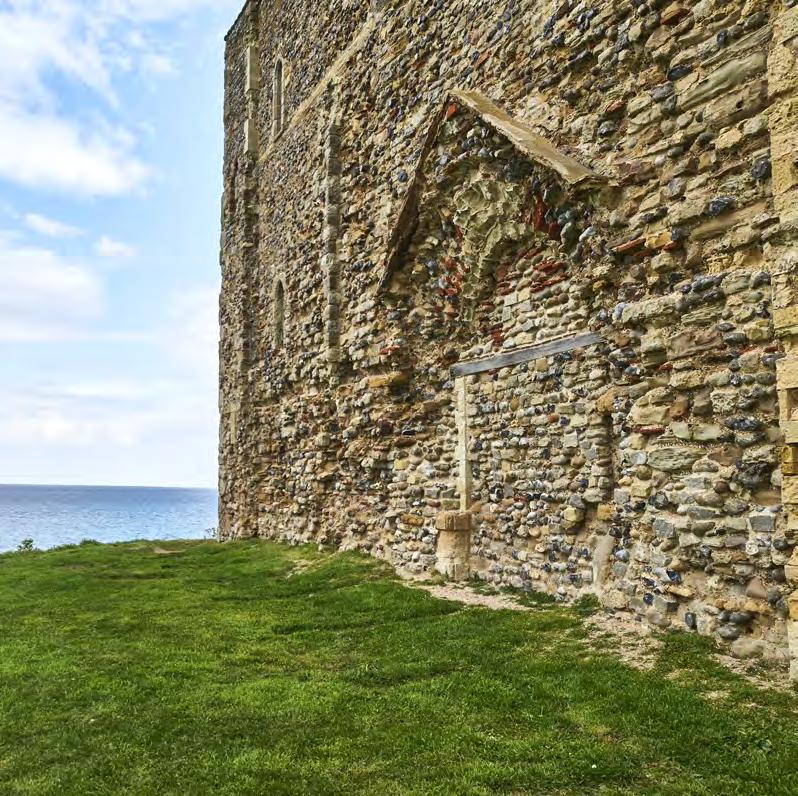
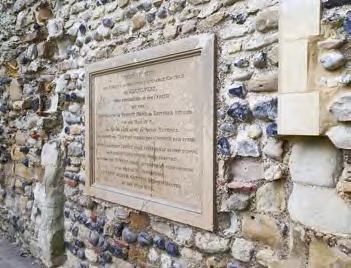

Left Reculver was the site of one of the earliest Saxon Shore forts
This plaque highlights how Trinity House recognised the towers as a naval landmark
Completed repairs to the walls that were originally part of a Roman fort

‘It’s unusual to have a parish church with two towers. They wanted to make a statement’
Creating the replacement mortar was equally complicated. ‘We took samples to match the historical mortar. But it also had to stop the damage from rainwater and work around the different stones: to be soft enough not to harm soft limestones but hard enough to work with the flint.’ Around Reculver I see evidence of this expertise. Cockle and oyster shell pieces in the mortar catch my eye. It’s hard to tell which patches are original and which parts are replacements.
‘I’m proud to have worked with such highly skilled craftsman,’ says Beeson of the team, which included architects Simpson & Brown, quantity surveyors Baker Mallett, Canterbury Archaeological Trust, restorers Paye Stonework, and an ecologist from David Archer Associates.
The most complex parts to conserve were the towers added in the 12th century. By this time, it was no longer a monastery but a parish church. ‘They wanted to make a statement with something tall,’ says Porter. ‘It’s quite unusual to have a parish church with two towers.’ Those towers were in danger of
collapsing when work began a few years ago, says Beeson: ‘The infilled arched doorway was so thin in parts that you could see daylight through it. And the timber supports of the towers’ roofs had rotted and needed replacing.’
Work was made even trickier by Reculver’s location and protected status. Alex Towle, contracts manager at Paye, recalls, ‘We had the cliff edge on one side and a narrow footpath on the other. We had to construct a nine-level-high, self-supporting scaffold but it couldn’t be tied into the building because it’s a scheduled monument.’
Although the coastal location contributed to the towers’ decline, it also helped save them. The church originally stood more than a mile from the sea but
by the end of the 18th century, coastal erosion had taken the sea less than fifty metres from its edge. The core of the church collapsed as the village declined. The parish moved up the road to Hillborough, taking some of the stone to build a new church there.
But in 1809, Trinity House, the institution that looks after Britain’s lighthouses, recognised their value as a naval landmark and stepped in to save them.
‘Trinity House put in the first sea defences under the cliff to protect the towers from erosion,’ says Porter. And this is where English Heritage will turn its attention to next.
‘The work we’ve just done means we won’t need to do another major project for a generation. Now we’re looking at what needs to be done over the next century to secure the monument, and that means its sea defences.’ I spend my last moments at Reculver looking over the defences, reflecting on this place that is so emblematic of the changing tides of history and so defiant of the waters threatening to claim it.
Discover more
To learn more about Reculver Towers and Roman Fort, or to plan a visit, go to www.english-heritage.org.uk/reculver

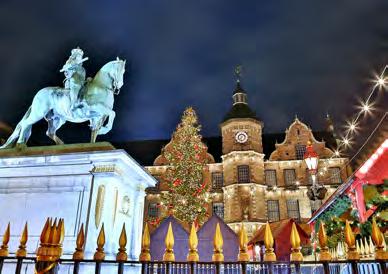

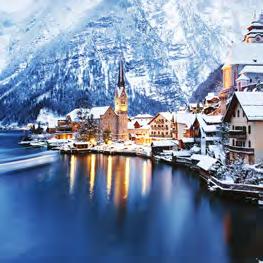

Enjoy a festive holiday with a difference
Book a hassle-free seasonal break with Leger Holidays, the UK’s leading coach tour provider
Make sure this Christmas is one to remember with Leger Holidays. Whether you’re looking to soak up the atmosphere of Christmas markets, or simply want a hassle-free break over Christmas or New Year, Leger has just the coach holiday for you, with spectacular European destinations across Germany, Austria, Italy, France and Spain.
With departure dates in November and December, the Düsseldorf & Cologne Christmas Markets tour includes three nights’ accommodation
‘You’ll be able to relax in the knowledge that everything on your holiday will be taken care of’
and will give you the chance to visit two of the finest festive markets in Germany – the perfect places to track down unique, handcrafted gifts. For an unforgettable holiday over Christmas itself, the Christmas Spectacular in Austria & Scenic Trains of the Tyrol tour takes in some of Austria’s most enchanting locations, including Kitzbühel and Salzburg, along with the chance to enjoy a stunning train journey on the Ziller Valley Railway. Or for an entirely different experience, the seven-day 5-Star New Year on the Spanish Coast tour takes in Spain’s picturesque coastlines, giving you the chance to visit Barcelona as well as Lloret de Mar and Tossa de Mar on the Costa Brava. Plus you’ll also enjoy a New Year’s Eve gala dinner. Whichever trip you choose, you’ll be able to relax in the knowledge that
everything on your holiday will be taken care of – leaving you free to make the most of your time away and enjoy the beautiful locations that you’ll visit. Every tour is fully escorted and includes coach travel from more than 500 local joining points across England and Wales, handpicked accommodation, selected meals and excursions. And with two luxury coach travel options, Silver Service and Luxuria, you can be sure that you’ll be travelling in comfort.

English Heritage members can save 5% on all Leger holidays. Go to www.leger.co.uk or call 01709 914937 and use the code MRPEH5
Members save £20 per room*

FESTIVALS MADE EFFORTLESS
World-renowned vocalists, bands and tribute acts take to the Warner Hotels stages
Whether it’s Motown & Soul or back to the 80s, every Warner Hotels festival is for people with a passion for the same genre or era of music. Dancing is judgement-free, the bar is open late and there are no worries about driving home.
Our weekend festival breaks feature at least five live acts, two in the afternoon and three in the evening, plus a nightly DJ keeping the party going until 1am. Midweek festivals offer seven acts with three daytime shows and four in the evening followed by the DJ.
Experience it for yourself. Visit the Warner Hotels website to find out more.




Share your thoughts, experiences, tips and photos
Pirate adventure
A quick thanks for the Pirates! event we attended with our granddaughter Georgi at Carisbrooke Castle as part of a camping trip to the Isle of Wight last summer. Not only did the theme appeal to her but some of our favourite musicians, GreenMatthews, were performing. After going through the imposing gateway of the castle, we headed to the inner green, which had medieval shopping and games tents, and an interesting pirate puppet theatre – which offered plenty of laughs, energy and the occasional flurry of water. Walking through the courtyard we were pleasantly surprised to see a large arena with cannons and a variety of
Kenilworth converts
STAR LETTER


pirate props. Splendid medieval tents ringed the arena, housing themed activities and costumed volunteers. We were treated to a whole day of events, including demonstrations of musket firings and a variety of talks – Georgi was fascinated by the lady who imported tea. We all had an amazing day and were really impressed with the quality of the event.
Andy Cooper

When my son was at infants school, he was often taken out at weekends by his grandparents. He was generally given a choice of where to go. His enthusiasm for visiting Kenilworth Castle was such that his teacher once asked me if it was true he often visited the site at weekends – it regularly featured in his Monday news! My granddaughter now has the same enthusiasm. The improvements made by English Heritage have been amazing since I also was taken there as a child.
Bobbie Kelly

Our star letter writer receives a prize from Craghoppers. This issue it’s a picnic blanket, tumbler and men’s or women’s fleece, worth over £100. For a chance to win, send us an email for publication.

Long-standing members
With reference to Nick Morgan’s letter in the Spring issue of the Members’ Magazine, 1978 is a bit late as far as I’m concerned! I can’t remember when I first bought a pass for entry to the historic properties that were cared for at the time by the Ministry of Works, but I’m guessing it was 1968. The first property I visited using my pass was Barnard Castle in Durham and I still have the guidebook, which I bought for 6d (pictured below). I would expect there are plenty more people who can go back further than that. Since 1968, I would estimate that I have visited 80 per cent or so of the properties now cared for by English Heritage.
Paul Wilcockson

Roman around I want to say thank you so much to all the helpful staff along the Hadrian’s Wall sites in Northumbria. I bought membership for my partner and I – and, by the end of the day, we’d already broken even after visiting Chesters, Housesteads and Birdoswald. The staff at each site really worked their socks off to bring the history of this amazing part of the world to life. Thanks a million, English Heritage!
Tex Fisher
Eye-opening visit
A recent visit to Ashby de la Zouch Castle in Leicestershire with a Canadian friend has really reinforced to me the importance of protecting historic places. I’ve been to the castle many times but her utter delight at visiting it made me re-evaluate the experience, as I found myself in the unlikely position of tour guide. It was fantastic to see the castle through her eyes. From this I have decided to take a new approach to visiting older buildings. Rather than seeing them as a pretty part of the scenery, I aim to find enjoyment out of the small details, marvel at their age, and ponder their uses throughout the years.
Lucy Newlyn
‘I bought membership while visiting Hadrian’s Wall and broke even by the end of the day, after visiting Chesters, Housesteads and Birdoswald’
Glorious gardens
My husband and love visiting Audley End House in Essex with our little dog. I would like to say a huge thank you to all the gardeners for their outstanding displays of spring flowers in pots and containers – so many different types of tulips, daffodils and narcissi. It was a magical visit.
Fiona Horner

Going back in time
Reading your article on Grime’s Graves in the Spring edition reminded me of a school trip to the site in the late 1960s when I was about 12. We were allowed to crawl on hands and knees through the tunnels – a very claustrophobic experience as I remember! I look forward to seeing the new work carried out as part of the Digging Deeper project.
Yvonne Cherry
King of the castles
When my husband and I moved to the UK in 2007, my husband set out to visit 100 castles. He even set up a spreadsheet to track them all. The vast majority have been English Heritage sites and partner sites. We’ve greatly enjoyed all the castle visits over the years. Maybe we’ll get in 100 more!
Amanda Taylor
Get in touch
Email your thoughts, tips and photos to membersmagazine@ ourmedia.co.uk
Send your questions to the English Heritage experts
SEND US A QUESTION
To get your questions answered, email us at membersmagazine@ ourmedia.co.uk
Dan Wetherby asks…
Why and when was the medieval village at Wharram Percy abandoned?
Dr Nick Holder, senior properties historian replies… Wharram Percy, in what is now North Yorkshire, experienced a long decline rather than a sudden abandonment. After famine in the 1310s, an attack by the Scots in 1322 and the Black Death in 1349, the village had declined from about 200 to 50 residents. Over the next 150 years several houses were abandoned. Some of the last families were evicted by the lord of the manor in about 1500 but a few held on. In a later legal case, the ex-villager Robert Pickering remembered that ‘the towne was laid to grasse’ in 1527. A wealthy sheep farmer, John Thorpe, seems to have persuaded the lord of the manor to evict the last cereal farmers so that he could run the former village as a profitable sheep farm.
Beatrice Walker asks…
How did the myth of Orford’s Wild Man of the Sea originate and what is its meaning?
Suzannah West, manager, Orford Castle replies…

Orford’s Wild Man (pictured) was first written about by Ralph de Coggeshall Chronicon Anglicanum around 1207, some 40 years after Henry II had Orford Castle built and when Bartholomew de Glanville was castle custodian. According to the story, local fishermen caught a hairy manlike creature in their nets, who was then imprisoned by de Glanville in the castle. He was tortured but remained mute. Some months later he escaped back to sea. De Coggeshall himself appeared unsure about the story’s truth. Legends about ‘wild men’, ‘green men’ or ‘woodwose’ were common in medieval folklore. Such tales would be told to explore aspects of humanity that were difficult to explain or understand. They also reflected people’s fascination with mystery and a fear of the unknown.
MEMBERS’ AREA
The latest exclusive online content

Members’ Week videos
Catch up on Members’ Week’s virtual events. www.english-heritage.org. uk/members-week

Kids’ competition
Design a medal for a chance to win a goody bag. www.english-heritage.org. uk/kids

Browse back issues See our digital magazines to read previous issues. www.english-heritage.org. uk/magazine




Discover Normandy
Celebrate the region’s fascinating past on a break with Brittany Ferries
Explore the rich history and vibrant culture of Normandy, a region brimming with tales of triumph and artistry. From its iconic D-Day landing beaches to its artistic heritage as the birthplace of Impressionism, Normandy offers a wealth of diverse experiences. Savour its culinary treasures, marvel at its landscapes and delve into its history.
In June 1944, D-Day altered the course of history as Allied soldiers landed in Normandy, beginning the liberation of Europe. To commemorate the 80th anniversary, Normandy has a programme of events celebrating peace, liberty and reconciliation. At the British Normandy Memorial, 1,475 silhouettes are displayed on
‘Normandy promises a journey of discovery, local traditions and breathtaking sights’
wild meadow fields to honour British fatalities on D-Day, as part of the Standing With Giants installation. There are also behind-the-scenes tours of the Airborne Museum in Sainte-Mère-Eglise, which help visitors to understand the role Allied paratroopers played in D-Day.
The region also celebrates the 150th anniversary of Impressionism this year with the Normandy Impressionist Festival. This offers exhibitions and experiences across the area, including a spectacular audio-visual show projected on to Rouen Cathedral and an exhibition by David Hockney.
A new immersive Viking Museum can also be found in Rouen, exploring Normandy’s Viking history along the Seine. Discover how the region became the most powerful in Europe in just a century, with a journey through 100 years of Viking invasions. In Honfleur, the reconstruction of William the
Conqueror’s flagship that led the Normans to England in 1066, La Mora, offers a glimpse into Norman history. Whether seeking adventure or tranquillity, Normandy promises a journey of discovery, local traditions and breathtaking sights. Brittany Ferries offers direct routes to Normandy with sailings from Portsmouth or Poole. By sailing direct to the region, your holiday will start the moment you drive aboard, from relaxing in your spacious en suite cabin to enjoying gourmet dining.

English Heritage members can save up to 5% on sailings and up to 7% on all ferry-inclusive holidays. To book, call 0330 173 7019 and quote ‘English Heritage’ or find out more at www. brittanyferries.com/englishheritage



































‘The views are breathtaking, as if little has changed in 500 years’
Member Bridget Gunston discovered that the evocative ruins of Middleham Castle are the perfect spot for a day out
Middleham Castle in North Yorkshire is a place I love to visit and I often wander around the ruins. I visit the site as often as I can in all seasons, usually about every two months. I like to see it in different lights from different viewpoints, to absorb the history there before browsing the souvenirs in the shop and having a coffee.
The castle is most beautifully situated on a hill above the town of Middleham. The views from the topmost tower are breathtaking and expansive, and I imagine little has changed in 500 years, apart from a few more houses and fewer trees. It is certainly worth the climb up the staircase to gaze across the landscape. From here you can look down through the walls of the Great Hall to the kitchens below, and admire outcrops of delicate harebells and wild thyme clinging tenaciously to the old stones.
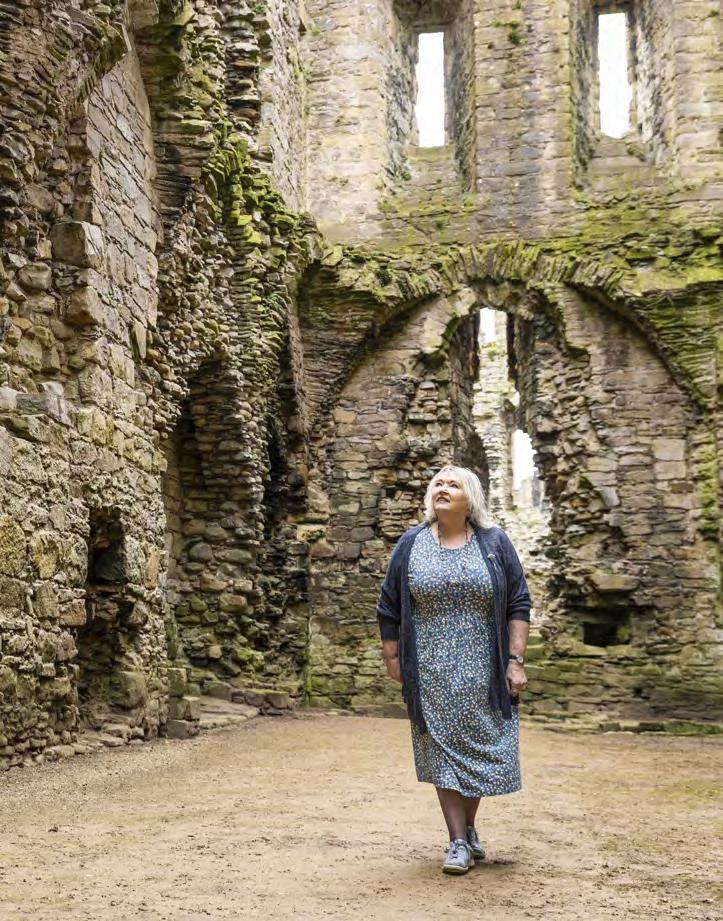
wait to explore the ruins and I was amazed at how impressive it is as you approach.
It’s not hard to imagine the castle in Richard’s time, with nobles feasting in the Great Hall or praying in the chapel, servants coming and going, soldiers honing their weapons by the guard house, and young Prince Edward of Middleham looking out from the D-shaped tower across the gardens. After I started visiting the castle, I felt so drawn to it that I was inspired to write my own interpretation of life here, and I published my first novel, Maid of Middleham, last year.
Email us at membersmagazine@ ourmedia.co.uk
I first started visiting here in 2015 after witnessing the procession for Richard III’s reburial in Leicester. I started reading everything I could about him and wanted to see the place where he had spent some of his youth, as ward of the Earl of Warwick, Richard Neville. I found Middleham Castle was only an hour’s drive from my house through the tranquil vale of Wensleydale. I couldn’t
Along with many other English Heritage castles here in the north, Middleham Castle continues to inspire me – ensuring I get the best possible value from my membership and at the same time augmenting my knowledge of history. It’s dog-friendly, children enjoy exploring and having fun with wooden swords and shields from the gift shop, and the staff are always welcoming. It really is a lovely place to visit for a day out.
www.english-heritage.org.uk/middlehamcastle
BRIDGET’S TIPS
My favourite feature is the south-east tower.
You can imagine the view from it has changed little since it was built.
A good photo spot is from the track leading down the side of the castle, past the stables.
Within the shop is an exhibition that includes a replica of the stunning Middleham jewel.


These fantastic Members’ Rewards are sure to get you buzzing this summer


20% Seasalt discount
Update your wardrobe for less this season with Seasalt’s beautifully designed clothes and accessories.
www.english-heritage.org.uk/rewards/ seasalt


Free eye test & 30% discount
Spend £50 or more in store to claim a free eye test, plus 30% off glasses, prescription sunglasses and contact lenses.
www.english-heritage.org.uk/rewards/ vision-express


Free case of beer
Claim a free case of ten beers from some of the world’s finest breweries courtesy of Beer52 – just cover postage. www.english-heritage.org.uk/rewards/ beer52


£75 off a case of wine
Make a huge saving on a case of 12 wines, all from independent makers, that have been picked by Naked Wines’ experts.
www.english-heritage.org.uk/rewards/ naked-wines


Save 15% with Sarah Raven
From an extensive range of seeds, plants and bulbs, to gardening kit and homeware, enjoy 15% off at Sarah Raven. www.english-heritage.org.uk/rewards/ sarah-raven


20% off bouquets & hampers
Appleyard offers an exciting selection of premium bouquets and luxurious hampers to treat your loved ones.
www.english-heritage.org.uk/rewards/ appleyard-flowers


Digitalis from just 89p
These beautiful nectar-rich flowers will add colour, height and drama to your borders this summer.
www.english-heritage.org.uk/rewards/ hayloft-foxgloves
What our members are saying



Read an exclusive interview
We chatted to bestselling author Susan Stokes-Chapman about her new Georgianset novel The Shadow Key
www.english-heritage.org.uk/rewards/ the-shadow-key

15% off online and in-store
Wherever your happy place is, Runners Need has got the kit to get you there. Enjoy a 15% discount in-store and online.
www.english-heritage.org.uk/rewards/ runners-need

‘We’ve made loads of savings with Members’ Rewards, most recently on the ferry travel for a family break on the Isle of Wight. And it’s great to know that every time we use an offer, we’re also further helping out English Heritage at the same time.’
Steven Webster, Bristol







20 questions
From Arthurian legends to secret Second World War tunnels, test your knowledge of the castles in our care with this just-for-fun quiz
1 Portchester Castle in Hampshire served as what during the Napoleonic Wars?

2 Who had a bowling green created for them while held prisoner at Carisbrooke Castle on the Isle of Wight (above)?
3 Despite its name, Stokesay Castle is actually what sort of building?
4 Maiden Castle in Dorset is one of the largest Iron Age hillforts in Europe. It’s the size of approximately how many football pitches?
5 Which Suffolk castle is referenced by Ed Sheeran’s song ‘Castle on the Hill’?
6 Can you unscramble the name of this medieval Northumberland fortress?
CATWALK THROWERS
7 Tunnels at Dover Castle were used as the HQ for which operation during the Second World War?

8 Richard II’s lost treasure is said to be hidden in which part of Beeston Castle (above)?
9 Can you identify this Warwickshire castle (below), known for its beautifully recreated Elizabethan garden?
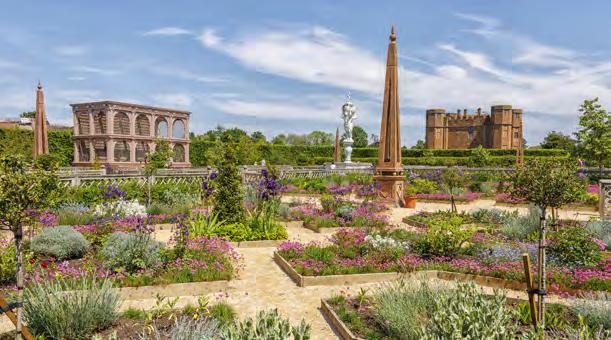
Log into the Members’ Area at www.english-heritage. org.uk/quizzes to check your answers

10 Bolsover Castle (above) was the aristocratic retreat of which Cavalier playboy?
11 Daws Castle was founded by King Alfred to defend the people of Watchet against attacks from…
A Romans B Vikings C Normans
12 Scarborough Castle’s great tower and south-facing walls were damaged in the early 20th century as a result of what?
13 Which castle in Cornwall was inspired by the legend of King Arthur?
14 Pevensey Castle in East Sussex is an example of what type of Roman fort?
15 Who did Sir Walter Hungerford III imprison in a tower at Farleigh Hungerford Castle for nearly four years in the 1530s?
16 Portland Castle, which overlooks Portland Harbour in Dorset, was built in the early 1540s on whose orders?
17 Which Kent castle has a garden that was created for the Queen Mother?
18 In which year did Earl Thomas of Lancaster begin building Dunstanburgh Castle?
A 1313
B 1413
C 1513
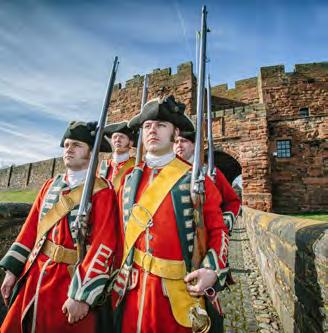
19 Who, in 1567, was housed in Carlisle Castle after fleeing from her rebellious subjects to England?
20 Drogo de la Beauvrière built Skipsea Castle after he was given the lordship of Holderness. Who awarded him the title?
Harry Mallin’s blue plaque
As the Paris Olympics get underway, we reveal the story of the double gold medal-winning boxer who triumphed at the city’s Games 100 years ago
Henry William – Harry –Mallin (1892–1969) is one of those London blue plaque recipients who is not a household name but probably ought to be. At the Olympics in 1924, he became the first boxer to successfully defend a title, taking the gold at middleweight in Paris to add to the medal he had won at Antwerp four years earlier.
Mallin was the first boxer to achieve a double gold – a feat not repeated until 1956, and not by a British boxer until Nicola Adams’ successful title defence in 2016. Mallin was also British amateur middleweight boxing champion for five consecutive years from 1919 – a record that has never been bettered.
Mallin’s Parisian triumph was controversial. His quarter-final opponent, a local favourite named Roger Brousse, was dubiously judged to have won on points, despite Mallin showing the referee bite marks on his arm and torso. A Swedish official complained and the result was overturned. Back home, the Daily
‘Mallin was the first boxer to achieve a double gold – a feat that was not repeated until 1956’
Sketch accused Brousse of ‘sampling the unroasted beef of old England’. Despite restive crowds in subsequent rounds, Mallin kept his cool and out-pointed his team-mate Jack Eliot in the final. He then retired from the sport, undefeated in more than 350 amateur contests. Once dubbed ‘the professor of the sweet science’, he was a thoughtful boxer who scored few knockouts and relied on technique.

Mallin went on to coach the British boxing teams at the Olympics of 1936 and 1952. He also had the distinction of
television sports commentary – on an England vs Ireland boxing match held at Alexandra Palace in February 1937. Sadly, no recording survives. By day, Mallin was an officer of the Metropolitan Police, from which he retired in 1952 after 37 years. His blue plaque marks a former section house – no-frills police accommodation – at 105 Regency Street, Pimlico, where he lived from 1923 until the Second World War. Mallin was born into a workingclass family in Hoxton and raised in
Hackney Wick. However, none of his earlier homes survive, nor does the Eton Manor Boys’ Club, where he honed his boxing skills. Ironically, its site is now occupied by the Lea Valley Hockey and Tennis Centre, originally built for the 2012 London Olympics.
Discover more
To learn more about the London blue plaques scheme and the stories of those commemorated through them, go to www.english-heritage.org.uk/blue-plaques



















